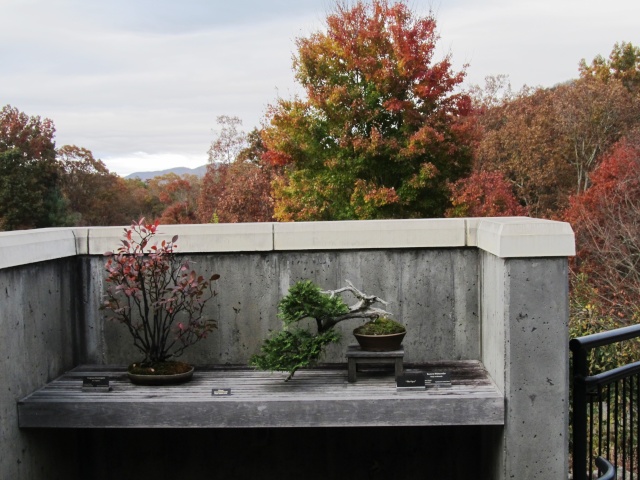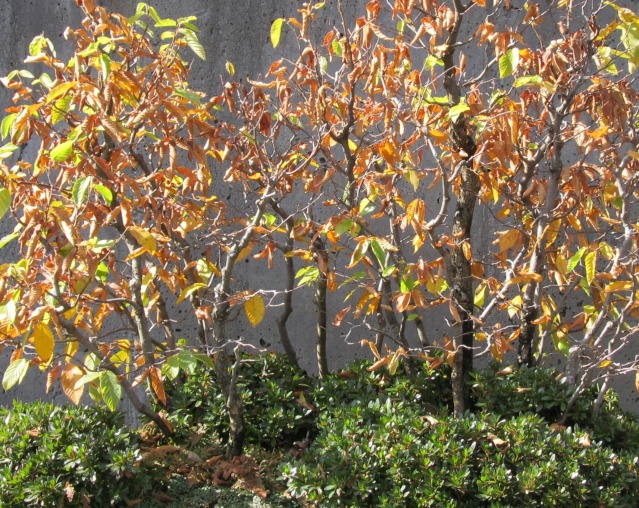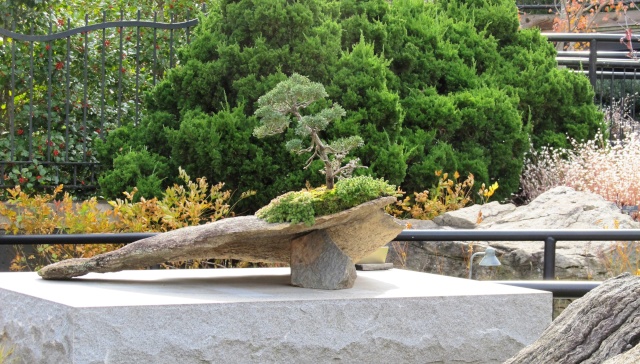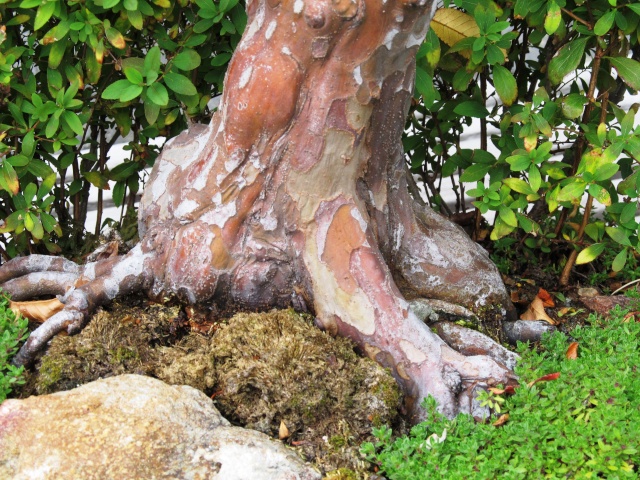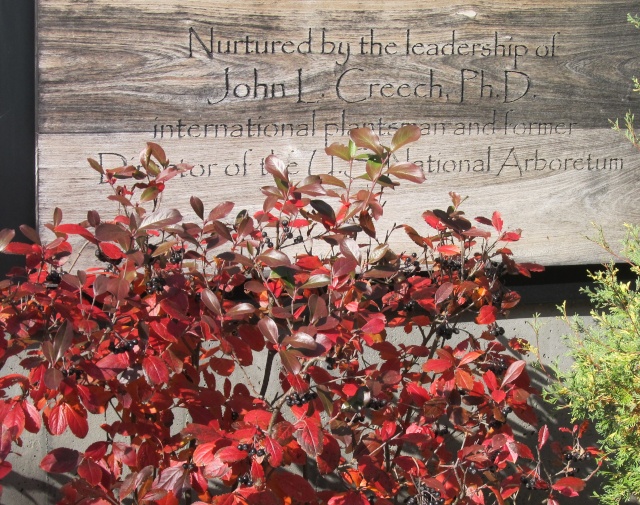American Bonsai at the NC Arboretum
+95
kingsnake
Tom
MKBonsai
BrianS
manumidam
Chris Cochrane
Intricate Simplicity
chench53
KyleT
Maros Belan
DjTommy
Bolero
Gonetopot
Rick36
M. Frary
Van
Toshiro
fiona
Precarious
drbuzzbee
geo
LanceMac10
MichaelS
kimo
Chellis
Leo Schordje
FrankP999
dick benbow
BrianG
crust
TN Jim
Seth Ellwood
Wander
peterkang
Judgie
Kevin S - Wisco Bonsai
Vance Wood
JMcCoy
brett2013
GerhardGerber
lordy
Eric Group
my nellie
steveb
Jaybird
Todd Ellis
jgeanangel
Daygan
AlainK
Richard S
Randy_Davis
Robert J. Baran
David Brunner
William N. Valavanis
Jkd2572
Dale Cochoy
Jesse McMahon
prestontolbert
yamasuri
bingregory
Stephen Krall
DougB
Ashiod
JADunnagan
sayotefries
JudyB
Dan W.
Khaimraj Seepersad
DuncanJH
Dave Murphy
monte
MikeG
augustine
Russell Coker
Kev Bailey
lennard
BigDave
Marty Weiser
Smithy
coh
tmmason10
dorothy7774
gman
Dave Leppo
hometeamrocker
bwaynef
Billy M. Rhodes
Walter Pall
Sam Ogranaja
JimLewis
MartinSweeney
bonsaisr
Auballagh
John Quinn
Arthur Joura
99 posters
Page 12 of 40
Page 12 of 40 •  1 ... 7 ... 11, 12, 13 ... 26 ... 40
1 ... 7 ... 11, 12, 13 ... 26 ... 40 
 Re: American Bonsai at the NC Arboretum
Re: American Bonsai at the NC Arboretum
If you take a look at the photo with the top third of the apex on the main trunk covered......it wouldn't take much to make the proportions on this tree appear much more spreading and appealing.
Lovely story, I'm glad you took the orphan into your home.
Lovely story, I'm glad you took the orphan into your home.
JudyB- Member
 Trees in Central Park
Trees in Central Park
Thanks to Wander, Doug, Kevin and Judy for each of your responses.
I think every good bonsai has 2 stories - the first being the actual history of the plant (where it came from, who worked on it, how it came to look the way it does, etc.) and the other being the story it tells (battered old survivor, growing on the mountain peak, "the lonesome pine", etc.) Right now, the Mission Olive I showed in the last post has a far better actual history than it does a suggested story. The tree as it is has surface appeal but not much character, beyond that stubby and rugged lower trunk. I will have to work on that.
As Wander pointed out, the transition from the stout base of the trunk to the thinner middle section is not so wonderful, but I do not think I will live long enough to see that change much, and I do not plan on dying anytime soon. I would have to move the plant into an oversize container and let it grow vigorously for many years to fatten up that undersized section, and then cut it back hard and grow a completely new top, which would take however many years more. In my view, it would not be worth the trouble to do that. I can live with the size differential as it is and I think as the tree ages and the newer parts attain the more textured bark that comes with age it will all work out. Judy, I did as you suggested and looked at the image of the Mission Olive with the top third blocked out, and I agree that looks about right. It is certainly a doable thing, but I expect even that more modest alteration will still take a couple of years to effect. Cutting off the present apex is easy enough, but training remaining parts into new positions and filling in the inevitable gaps takes time, even with a plant that gets to grow pretty much all through the year. I expect I will do it, though, and that will help with this bonsai's current character deficiency.
*****************************************************************************************************************************************************************
Last week I was out of the office and away on a family trip. I spent a day in Manhattan with my 2 sons and of course the visit included a long walk in Central Park. For those who do not know, Central Park sits right smack in the middle of the magnificent jumble of steel and glass, concrete and asphalt that covers Manhattan island, which itself is the heart of the most populous city in the United States - New York. The park covers 843 acres and was built in the mid to late 19th century. Designed in part by Frederick Law Olmsted, the father of American landscape architecture, it is the most visited park in the US and stands as a model of visionary urban planning. For all the millions of people who live and work in New York City, spending their days stuffed in little boxes which are themselves stacked atop each other within gigantic boxes, fighting their way through the crowded streets or hurtling along in mechanical worms that race through grimy tunnels under the ground, Central Park is an oasis of leafy green, boulder and wood that offers a chance to step out of the rush and tumult, to feel the earth underfoot, hear the birds sing and look up to the open face of the sky. It is an opportunity for the most city-ish of city people to experience the balm of nature.
It is also an outstanding place to see an impressive variety of great old trees. That is always at the top of my list of things to do when I am there, and this time was no exception. But I was with my sons, and although they indulge my interest in megaflora they do not fully share it, so I was not at liberty to go about it as I would if I was on my own. Still, I managed to take a few pictures, and these I share with you now.
This first image is, I think, a Honey Locust (Gleditsia triacanthos):

I have to guess at this tree's identity because I did not see a label on it, and there are so many different species of plants used in Central Park that it could easily be something else. In fact, looking at the photo now I do not see the prominent thorns that bristle out all over the trunk and limbs of most honey locusts, so it may well be some other related or similar species. My interest in this tree was for the look of it, though, and not particularly for its species. The abruptly angular nature of this specimen makes, in my view, a great model for shaping deciduous bonsai, yet I have seen few deciduous bonsai that have it.
In another case of uncertain identity, this next tree I take to be an American Sycamore (Platanus occidentalis), but it could be some other Platanus species or hybrid:

The children playing beneath it give you some sense of the size of this tree. I like its shape, particularly the length to which the branches extend. It is clearly outside the standard trunk to branch ratio employed in bonsai design. Would you find a bonsai shaped similarly to this tree to be acceptable?
This is a Kwansan Cherry (Prunus serrulata 'Kwansan'), and I am confident of that because it was labeled:

In addition to the interesting shape of the tree in the foreground, I enjoy the relationship between it and the twin-trunk tree in the background. Again, such an arrangement would be possible in bonsai form, but I wonder how it would be received.
This is an American Elm (Ulmus americana):
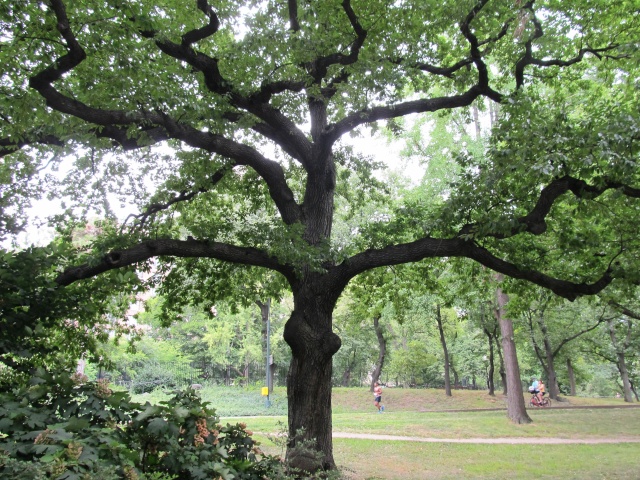
When I saw this tree I immediately thought of a work by my old painter-hero, Paul Cezanne:
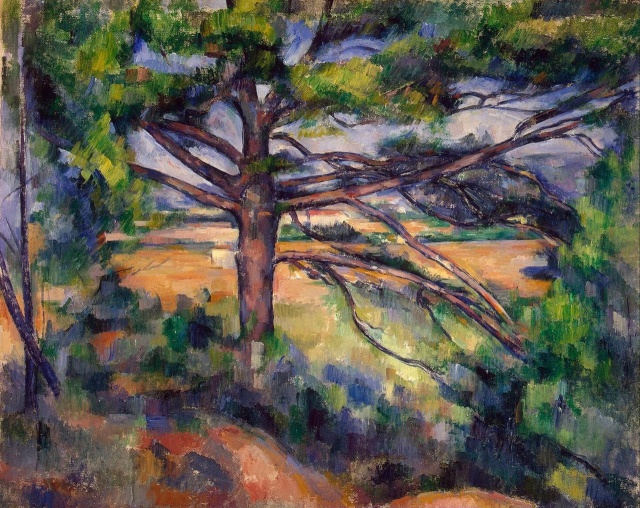
Not likely Cezanne's tree was an American elm, but the shape is remarkably similar. My guess is that this is a not uncommon form for a deciduous tree to assume, but have you ever seen a bonsai shaped this way? Heaven forbid - it has both knobby scars and bar branches! Yet one of the greatest artists in history thought such a tree to be a worthy subject (although Cezanne's tree trades the knobby scars for the perhaps even more offensive sin of reverse taper.)
Speaking of American elms, there are many of them in Central Park:
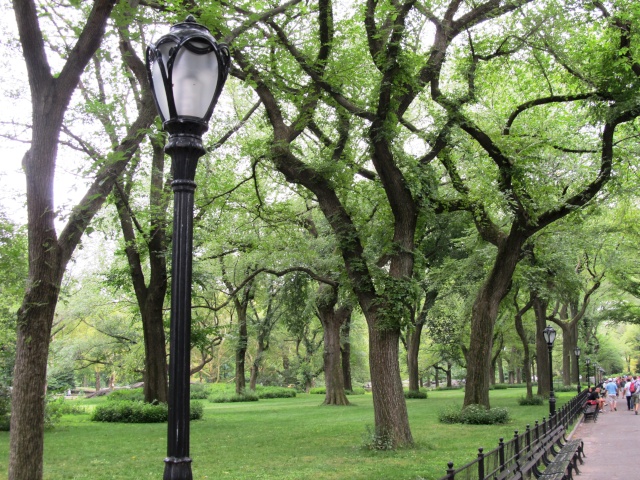
As it happens, the forms exhibited by these trees remind me of another Cezanne painting:
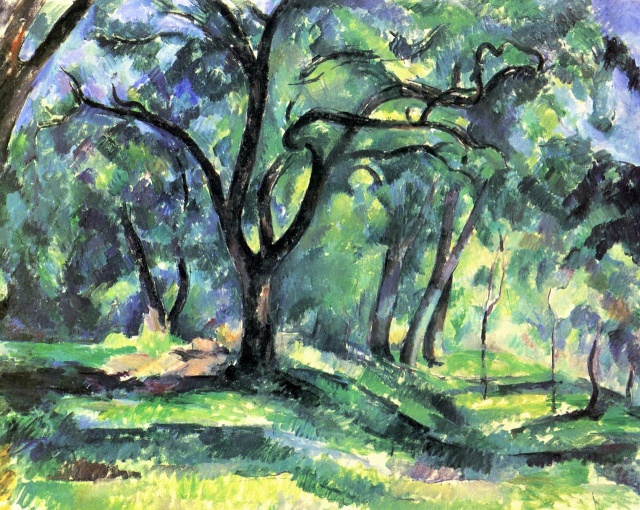
In both the photograph and the painting, take note of the long and sinuous, and in some random cases contorted, shape of the branches. That trees both deciduous and coniferous often assume such shapes is an observable fact all over the world, and was in Cezanne's time as well. Yet once again it is a look seldom found in bonsai design. Such a look is achievable in bonsai, so the dearth of specimens featuring it must be attributable to some other reason.
The preceding image of the American elms shows a small section off to the side of the famous Central Park Mall. This is a mall in the old sense of the word, and not a place to go shopping. A long, wide promenade, this is a pastoral place where people stroll, or skate, or ride bicycles, or simply sit and watch the people parade go by under the arching limbs of great elm trees. I would not call it an allée because the elms do not simply line the walkway, but rather the walkway goes through the middle of an entire grove of American elm trees. I do not think many of the people who seek refuge at the Central Park Mall necessarily know or care that the trees are American elms. They enjoy them for their their shade in the summer and their stately grace all through the year, and they come there for the feeling of the place. The feeling is perceived by the humans, but largely provided by the trees:

No visit to Central Park is complete for me without stopping in at the Metropolitan Museum of Art, which is situated within the park on its eastern boundary. There was a special exhibit at the museum featuring artwork from the Edo Period in Japan, and I went through it because, despite what some people may think, my preference for Western art does not preclude an appreciation for other kinds. I will leave you with this image from that exhibit:

A small detail from a large, six-panel folding screen painted by Kano Sansetsu in the mid-17th century. (www.metmuseum.org)
I think every good bonsai has 2 stories - the first being the actual history of the plant (where it came from, who worked on it, how it came to look the way it does, etc.) and the other being the story it tells (battered old survivor, growing on the mountain peak, "the lonesome pine", etc.) Right now, the Mission Olive I showed in the last post has a far better actual history than it does a suggested story. The tree as it is has surface appeal but not much character, beyond that stubby and rugged lower trunk. I will have to work on that.
As Wander pointed out, the transition from the stout base of the trunk to the thinner middle section is not so wonderful, but I do not think I will live long enough to see that change much, and I do not plan on dying anytime soon. I would have to move the plant into an oversize container and let it grow vigorously for many years to fatten up that undersized section, and then cut it back hard and grow a completely new top, which would take however many years more. In my view, it would not be worth the trouble to do that. I can live with the size differential as it is and I think as the tree ages and the newer parts attain the more textured bark that comes with age it will all work out. Judy, I did as you suggested and looked at the image of the Mission Olive with the top third blocked out, and I agree that looks about right. It is certainly a doable thing, but I expect even that more modest alteration will still take a couple of years to effect. Cutting off the present apex is easy enough, but training remaining parts into new positions and filling in the inevitable gaps takes time, even with a plant that gets to grow pretty much all through the year. I expect I will do it, though, and that will help with this bonsai's current character deficiency.
*****************************************************************************************************************************************************************
Last week I was out of the office and away on a family trip. I spent a day in Manhattan with my 2 sons and of course the visit included a long walk in Central Park. For those who do not know, Central Park sits right smack in the middle of the magnificent jumble of steel and glass, concrete and asphalt that covers Manhattan island, which itself is the heart of the most populous city in the United States - New York. The park covers 843 acres and was built in the mid to late 19th century. Designed in part by Frederick Law Olmsted, the father of American landscape architecture, it is the most visited park in the US and stands as a model of visionary urban planning. For all the millions of people who live and work in New York City, spending their days stuffed in little boxes which are themselves stacked atop each other within gigantic boxes, fighting their way through the crowded streets or hurtling along in mechanical worms that race through grimy tunnels under the ground, Central Park is an oasis of leafy green, boulder and wood that offers a chance to step out of the rush and tumult, to feel the earth underfoot, hear the birds sing and look up to the open face of the sky. It is an opportunity for the most city-ish of city people to experience the balm of nature.
It is also an outstanding place to see an impressive variety of great old trees. That is always at the top of my list of things to do when I am there, and this time was no exception. But I was with my sons, and although they indulge my interest in megaflora they do not fully share it, so I was not at liberty to go about it as I would if I was on my own. Still, I managed to take a few pictures, and these I share with you now.
This first image is, I think, a Honey Locust (Gleditsia triacanthos):

I have to guess at this tree's identity because I did not see a label on it, and there are so many different species of plants used in Central Park that it could easily be something else. In fact, looking at the photo now I do not see the prominent thorns that bristle out all over the trunk and limbs of most honey locusts, so it may well be some other related or similar species. My interest in this tree was for the look of it, though, and not particularly for its species. The abruptly angular nature of this specimen makes, in my view, a great model for shaping deciduous bonsai, yet I have seen few deciduous bonsai that have it.
In another case of uncertain identity, this next tree I take to be an American Sycamore (Platanus occidentalis), but it could be some other Platanus species or hybrid:

The children playing beneath it give you some sense of the size of this tree. I like its shape, particularly the length to which the branches extend. It is clearly outside the standard trunk to branch ratio employed in bonsai design. Would you find a bonsai shaped similarly to this tree to be acceptable?
This is a Kwansan Cherry (Prunus serrulata 'Kwansan'), and I am confident of that because it was labeled:

In addition to the interesting shape of the tree in the foreground, I enjoy the relationship between it and the twin-trunk tree in the background. Again, such an arrangement would be possible in bonsai form, but I wonder how it would be received.
This is an American Elm (Ulmus americana):

When I saw this tree I immediately thought of a work by my old painter-hero, Paul Cezanne:

Not likely Cezanne's tree was an American elm, but the shape is remarkably similar. My guess is that this is a not uncommon form for a deciduous tree to assume, but have you ever seen a bonsai shaped this way? Heaven forbid - it has both knobby scars and bar branches! Yet one of the greatest artists in history thought such a tree to be a worthy subject (although Cezanne's tree trades the knobby scars for the perhaps even more offensive sin of reverse taper.)
Speaking of American elms, there are many of them in Central Park:

As it happens, the forms exhibited by these trees remind me of another Cezanne painting:

In both the photograph and the painting, take note of the long and sinuous, and in some random cases contorted, shape of the branches. That trees both deciduous and coniferous often assume such shapes is an observable fact all over the world, and was in Cezanne's time as well. Yet once again it is a look seldom found in bonsai design. Such a look is achievable in bonsai, so the dearth of specimens featuring it must be attributable to some other reason.
The preceding image of the American elms shows a small section off to the side of the famous Central Park Mall. This is a mall in the old sense of the word, and not a place to go shopping. A long, wide promenade, this is a pastoral place where people stroll, or skate, or ride bicycles, or simply sit and watch the people parade go by under the arching limbs of great elm trees. I would not call it an allée because the elms do not simply line the walkway, but rather the walkway goes through the middle of an entire grove of American elm trees. I do not think many of the people who seek refuge at the Central Park Mall necessarily know or care that the trees are American elms. They enjoy them for their their shade in the summer and their stately grace all through the year, and they come there for the feeling of the place. The feeling is perceived by the humans, but largely provided by the trees:

No visit to Central Park is complete for me without stopping in at the Metropolitan Museum of Art, which is situated within the park on its eastern boundary. There was a special exhibit at the museum featuring artwork from the Edo Period in Japan, and I went through it because, despite what some people may think, my preference for Western art does not preclude an appreciation for other kinds. I will leave you with this image from that exhibit:

A small detail from a large, six-panel folding screen painted by Kano Sansetsu in the mid-17th century. (www.metmuseum.org)
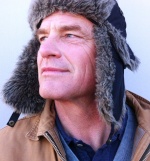
Arthur Joura- Member
 Re: American Bonsai at the NC Arboretum
Re: American Bonsai at the NC Arboretum
NYC 1979... where would i go ?
CBGBs to catch the dead boys, 'natch !
(though i was lucky enough to see them in milwaukee in 1979,
and on a 6 inch stage, 2 feet from stiv, no less !)
2014 ?
central park without a doubt...
i have "skirted" NYC many years ago, but had no desire to pull into town...
now-a-days, i wish i could fly in for 1 day just to experience the oasis in the middle of that sea of humanity and chaos...
and i think the taxi-cab ride from the airport to the park and back to the airport (with no other stops),
would serve as the perfect contrast between the 2 worlds.
CBGBs to catch the dead boys, 'natch !
(though i was lucky enough to see them in milwaukee in 1979,
and on a 6 inch stage, 2 feet from stiv, no less !)
2014 ?
central park without a doubt...
i have "skirted" NYC many years ago, but had no desire to pull into town...
now-a-days, i wish i could fly in for 1 day just to experience the oasis in the middle of that sea of humanity and chaos...
and i think the taxi-cab ride from the airport to the park and back to the airport (with no other stops),
would serve as the perfect contrast between the 2 worlds.

Kevin S - Wisco Bonsai- Member
 Re: American Bonsai at the NC Arboretum
Re: American Bonsai at the NC Arboretum
Great! I'm looking forward to your upcoming post on the other Limber. 

Dan W.- Member
 Baldcypress Tray Landscape, Repair and Repotting
Baldcypress Tray Landscape, Repair and Repotting
Thank you to Kevin and Dan for checking in.
It seems to me I am too much in the habit of complaining on this forum about having too little time and to much to do with it. I cannot think of a good reason to quit doing so now, what with the 19th Carolina Bonsai Expo looming less than 6 weeks away and the 4th US National Bonsai Exhibition taking place this weekend (I will be heading to Rochester, NY in a couple of days and taking an NC Arboretum display with me.) I have been neglectful of this thread for several months and feel badly about that, but I do what I can as I can.
I did a significant repotting project recently and documented it with many photographs. I am going to post them here and provide at least some description of what they show, but those of you who may have developed a taste for my verbosity will be disappointed. I need to limit the time I take doing this, so you will be getting the abridged version of it.
First of all, recognition to Mr. Brook Zhao, the great Chinese penjing artist who created the tray landscape Baldcypress (Taxodium distichum) forest that was the subject of the repotting. Here he is just after the completion of his demonstration in 1998, standing before the newly completed work:

Here is Mr. Zhao picking out the trees for his landscape, choosing among the many young baldcypress plants that can be seen on the ground behind him:

Here is an early photograph of the baldcypress landscape, taken in 2006:

The same, in November of 2012:

Here is an image made this year, just prior to the repotting work:
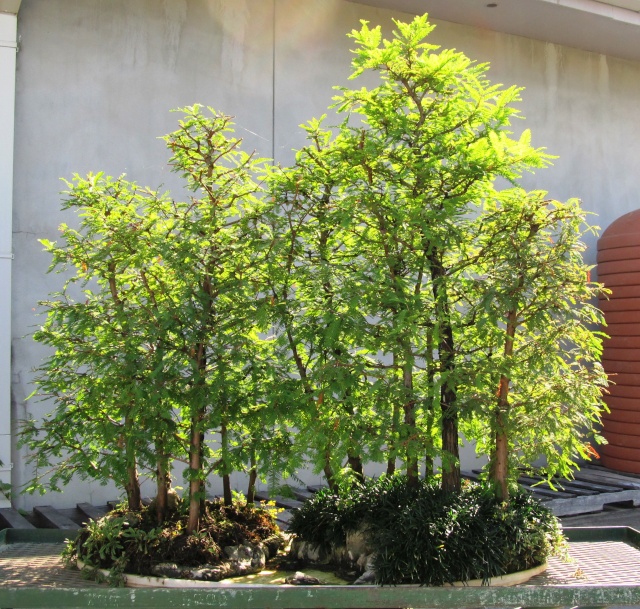
You will notice in the above image that the planting looks rather ragged. I knew at the start of the growing season that the repotting needed to happen this year, but because baldcypress can be repotted in the summer I opted to let this planting sit out of sight in the growing area, more or less neglected. This served no good purpose beyond freeing me to do other things in the meantime.
In the following 2 pictures you can see a problem that arose last year, when the roots of the trees were so packed into the available space that they used their hydraulic force to lift up the rocks that formed the boundary of the suggested stream running through the middle of the landscape. These rocks, brought from China, had been cemented to the marble slab by Mr. Zhao in his demonstration. They had once before been dislodged by baldcypress roots looking for more room to grow, and I had repaired them. Now they were being lifted again and this had to be addressed:


I should mention here that I was assisted in this project by my friend and sometime volunteer assistant, Charlie "C-dog" Dunnagan. In the next 2 images you see Charlie's hands picking up the 2 soil masses on either side of the suggested stream, and you see how the rocks lifted right off of the marble along with them:
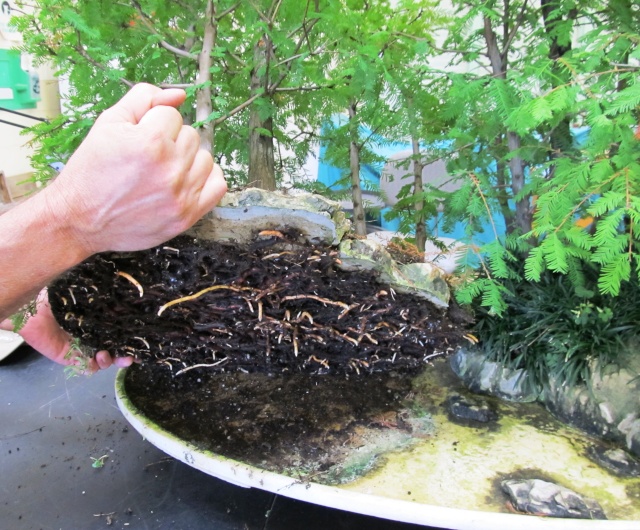
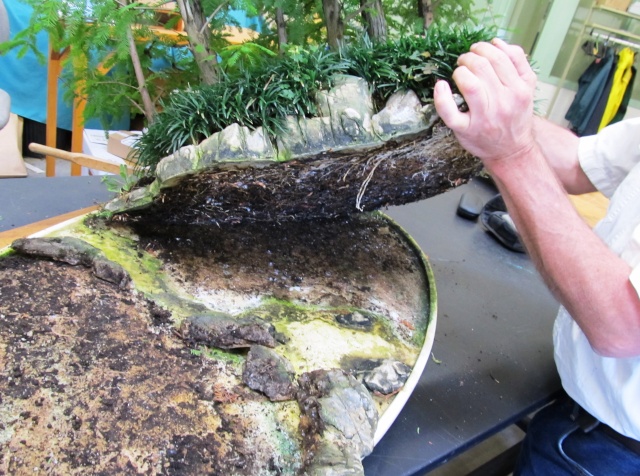
A spray of water was then used to blast away the coarse medium that remained on the marble slab:
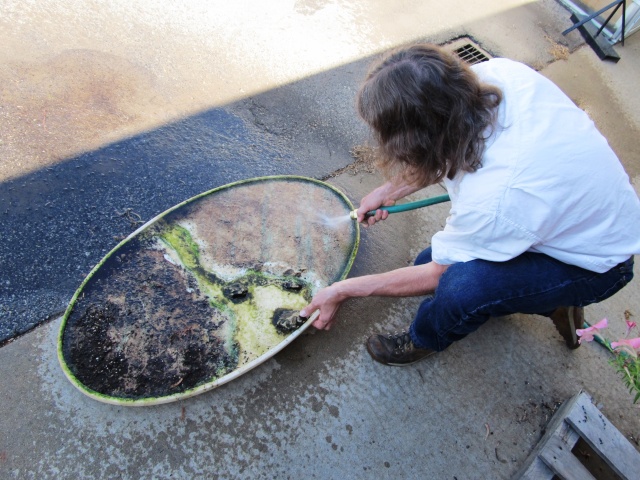
The white marble was heavily stained by the medium and algae, so we took to scrubbing it with a scraper and a variety of stiff brushes:
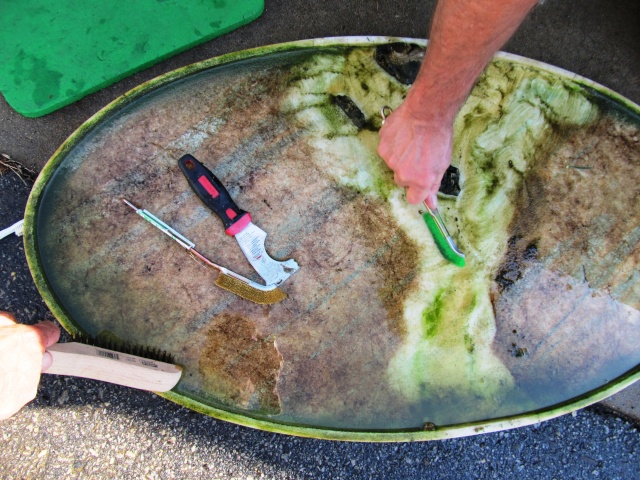
It did not come clean enough, so then we used baking soda:
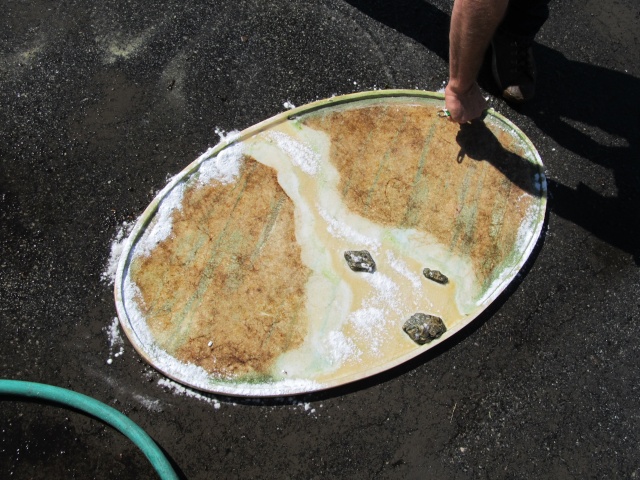
A good deal of staining remained, however. Interesting to note in this next picture that the cleanest part of the slab was that which was covered by the stones that were attached to it:

I was resigned to the fact that the marble was not going to be cleaned to the point of being "good as new". But the algae stains along the rim of the slab still bothered me so I decided to try vinegar, which is a fairly strong acid. C-dog, who was either a professional geologist or an alchemist in his working life (I can never remember which), offered that if I wanted something caustic he could go home and get me "some of the good stuff", but he could not guarantee that it would not dissolve the marble as well. I went with the vinegar:
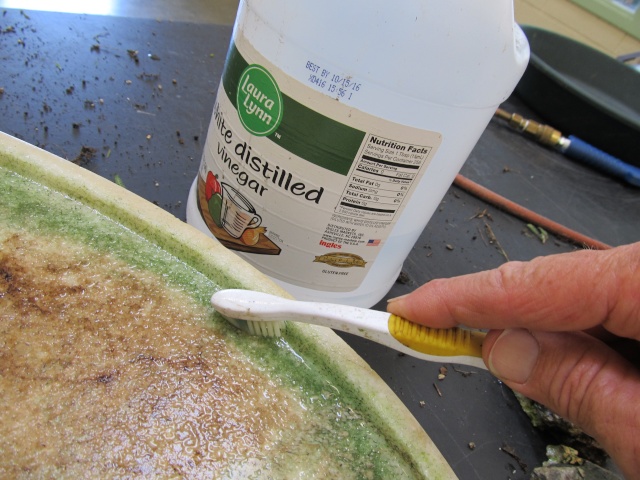
The vinegar did some good, but a bit of the algae remained nonetheless. Looking at the above photograph, I now notice that the vinegar label proudly proclaims that the product is "gluten free", which should be taken as a testimony to the boundless creativity and inherent deceptiveness of marketing people.
We were now ready to reapply the stones to the marble. I had gone to the hardware store and read all the labels of the various products I thought might do the job, and wound up choosing this one:
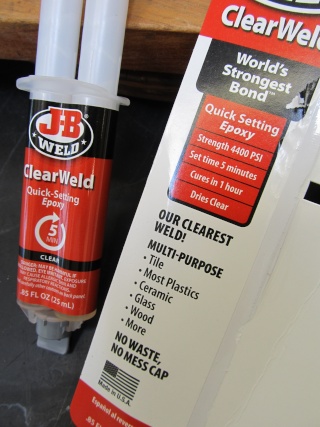
This should not be read as a product endorsement because only time will tell if this epoxy will hold up to the pressure when the roots return. However, I chose it because of the advertised set and curing times, and the amount of p.s.i. pressure it claims to be able to withstand.
The rocks were reset, taking care to place them just as Mr. Zhao originally did:
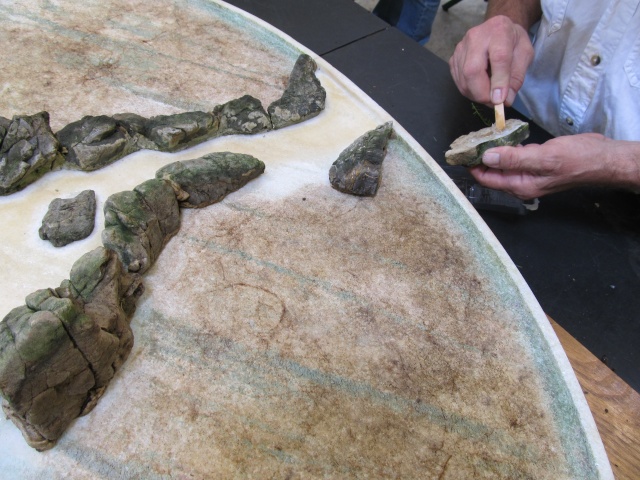

As the epoxied stones were allowed to set and cure, Charlie and I turned our attention to addressing the roots:
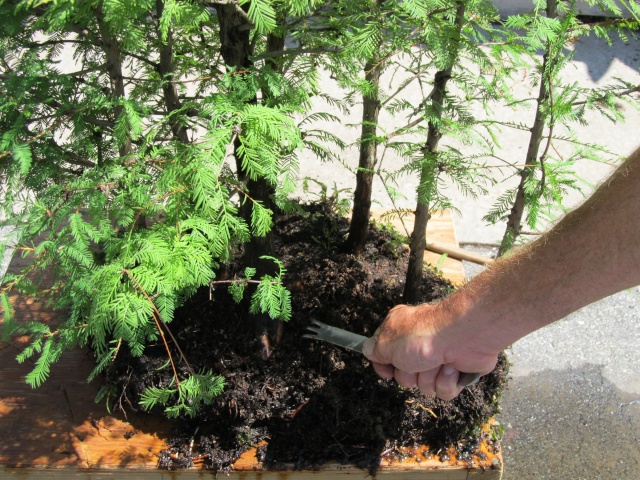
First we raked them out and then we sprayed them with a strong stream of water:
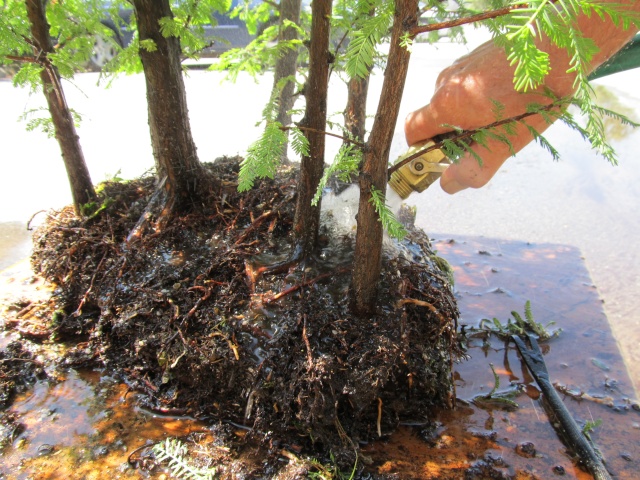
Then the roots that had piled themselves on the top of the soil surface were trimmed:
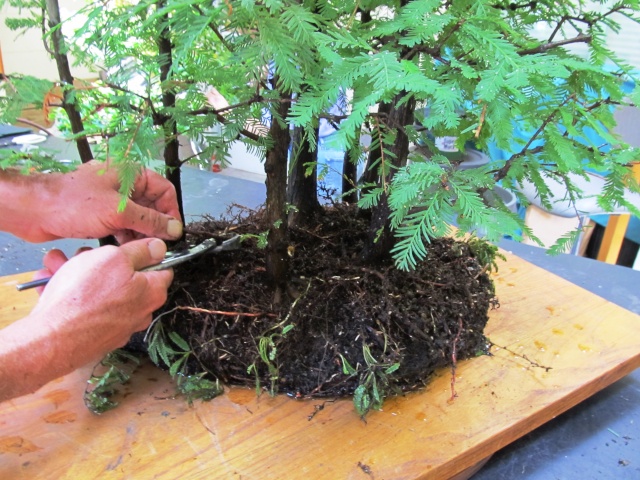
A shot showing how packed the roots were on the bottom:

Time for the weapon of mass destruction:

A trophy piece for the wall of the work area:
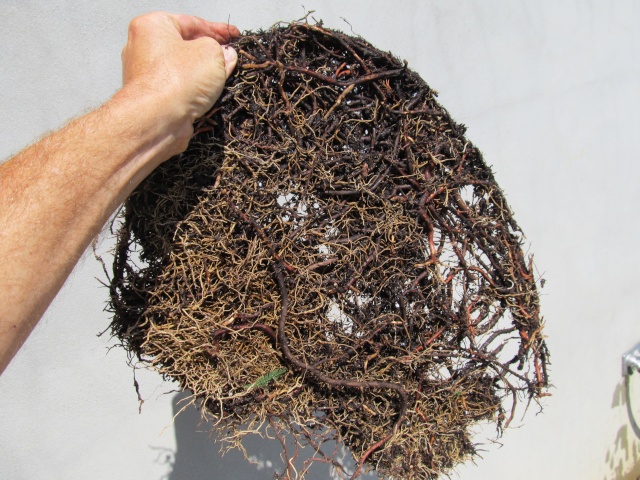
The planting naturally divided into 2 sections, one to either side of the suggested stream running between them, so we addressed first one and then the other. The 2nd one had a dense underplanting of Mondo Grass (Ophiopogon japonicus). There were only a few plugs of it used back when the landscape was originally planted, but they had done well for themselves and multiplied into a monster mondo-mat. We had to tear into it with great force:

Here, with their tops cut off, you can see exactly how dense the mondo grass had become:
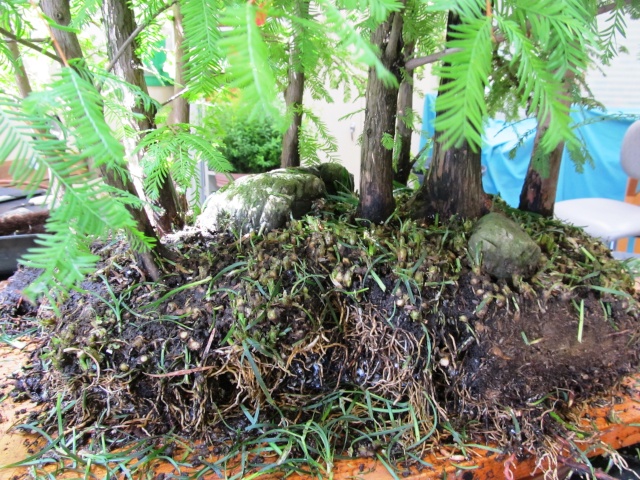
It took a long time to weed out by the roots as much of the mondo grass as we could, and I cannot be certain we got rid of it all. I decided to not plant any of it back, although I would not be surprised if it returned, like a plant version of the Terminator.
Finally the 2 sections of root mass were trimmed and ready for reassembly:

At this point, about 4 hours after we had begun, C-dog left me to finish on my own, muttering on his way out something about having a life. So I thanked him for his time and good help and went about the business of putting the landscape back together. First, a bed of fresh medium for the root masses to sit upon:

The 2 sections back in place:
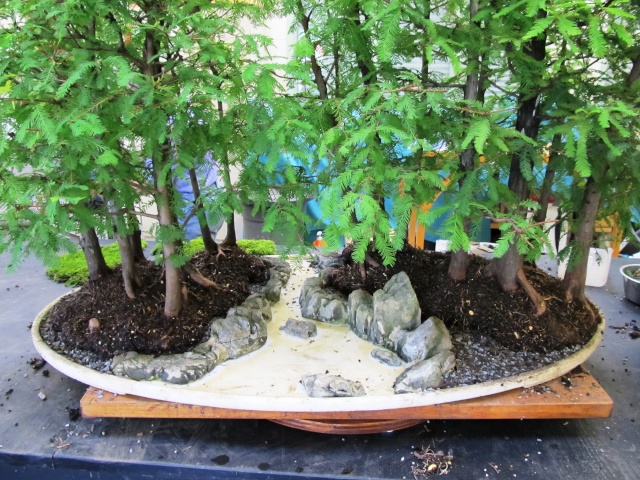
Packing muck around the periphery of the root masses:

Then another volunteer, my longtime, faithful assistant Virginia Turner, went to work applying moss to hold the muck in place:

Finally, after about 13 person-hours of work, the completed project:

For the sake of easy comparison, here in succession are images of this baldcypress tray landscape from 2006, before the repotting, and after:



That's all, folks!
It seems to me I am too much in the habit of complaining on this forum about having too little time and to much to do with it. I cannot think of a good reason to quit doing so now, what with the 19th Carolina Bonsai Expo looming less than 6 weeks away and the 4th US National Bonsai Exhibition taking place this weekend (I will be heading to Rochester, NY in a couple of days and taking an NC Arboretum display with me.) I have been neglectful of this thread for several months and feel badly about that, but I do what I can as I can.
I did a significant repotting project recently and documented it with many photographs. I am going to post them here and provide at least some description of what they show, but those of you who may have developed a taste for my verbosity will be disappointed. I need to limit the time I take doing this, so you will be getting the abridged version of it.
First of all, recognition to Mr. Brook Zhao, the great Chinese penjing artist who created the tray landscape Baldcypress (Taxodium distichum) forest that was the subject of the repotting. Here he is just after the completion of his demonstration in 1998, standing before the newly completed work:

Here is Mr. Zhao picking out the trees for his landscape, choosing among the many young baldcypress plants that can be seen on the ground behind him:

Here is an early photograph of the baldcypress landscape, taken in 2006:

The same, in November of 2012:

Here is an image made this year, just prior to the repotting work:

You will notice in the above image that the planting looks rather ragged. I knew at the start of the growing season that the repotting needed to happen this year, but because baldcypress can be repotted in the summer I opted to let this planting sit out of sight in the growing area, more or less neglected. This served no good purpose beyond freeing me to do other things in the meantime.
In the following 2 pictures you can see a problem that arose last year, when the roots of the trees were so packed into the available space that they used their hydraulic force to lift up the rocks that formed the boundary of the suggested stream running through the middle of the landscape. These rocks, brought from China, had been cemented to the marble slab by Mr. Zhao in his demonstration. They had once before been dislodged by baldcypress roots looking for more room to grow, and I had repaired them. Now they were being lifted again and this had to be addressed:


I should mention here that I was assisted in this project by my friend and sometime volunteer assistant, Charlie "C-dog" Dunnagan. In the next 2 images you see Charlie's hands picking up the 2 soil masses on either side of the suggested stream, and you see how the rocks lifted right off of the marble along with them:


A spray of water was then used to blast away the coarse medium that remained on the marble slab:

The white marble was heavily stained by the medium and algae, so we took to scrubbing it with a scraper and a variety of stiff brushes:

It did not come clean enough, so then we used baking soda:

A good deal of staining remained, however. Interesting to note in this next picture that the cleanest part of the slab was that which was covered by the stones that were attached to it:

I was resigned to the fact that the marble was not going to be cleaned to the point of being "good as new". But the algae stains along the rim of the slab still bothered me so I decided to try vinegar, which is a fairly strong acid. C-dog, who was either a professional geologist or an alchemist in his working life (I can never remember which), offered that if I wanted something caustic he could go home and get me "some of the good stuff", but he could not guarantee that it would not dissolve the marble as well. I went with the vinegar:

The vinegar did some good, but a bit of the algae remained nonetheless. Looking at the above photograph, I now notice that the vinegar label proudly proclaims that the product is "gluten free", which should be taken as a testimony to the boundless creativity and inherent deceptiveness of marketing people.
We were now ready to reapply the stones to the marble. I had gone to the hardware store and read all the labels of the various products I thought might do the job, and wound up choosing this one:

This should not be read as a product endorsement because only time will tell if this epoxy will hold up to the pressure when the roots return. However, I chose it because of the advertised set and curing times, and the amount of p.s.i. pressure it claims to be able to withstand.
The rocks were reset, taking care to place them just as Mr. Zhao originally did:


As the epoxied stones were allowed to set and cure, Charlie and I turned our attention to addressing the roots:

First we raked them out and then we sprayed them with a strong stream of water:

Then the roots that had piled themselves on the top of the soil surface were trimmed:

A shot showing how packed the roots were on the bottom:

Time for the weapon of mass destruction:

A trophy piece for the wall of the work area:

The planting naturally divided into 2 sections, one to either side of the suggested stream running between them, so we addressed first one and then the other. The 2nd one had a dense underplanting of Mondo Grass (Ophiopogon japonicus). There were only a few plugs of it used back when the landscape was originally planted, but they had done well for themselves and multiplied into a monster mondo-mat. We had to tear into it with great force:

Here, with their tops cut off, you can see exactly how dense the mondo grass had become:

It took a long time to weed out by the roots as much of the mondo grass as we could, and I cannot be certain we got rid of it all. I decided to not plant any of it back, although I would not be surprised if it returned, like a plant version of the Terminator.
Finally the 2 sections of root mass were trimmed and ready for reassembly:

At this point, about 4 hours after we had begun, C-dog left me to finish on my own, muttering on his way out something about having a life. So I thanked him for his time and good help and went about the business of putting the landscape back together. First, a bed of fresh medium for the root masses to sit upon:

The 2 sections back in place:

Packing muck around the periphery of the root masses:

Then another volunteer, my longtime, faithful assistant Virginia Turner, went to work applying moss to hold the muck in place:

Finally, after about 13 person-hours of work, the completed project:

For the sake of easy comparison, here in succession are images of this baldcypress tray landscape from 2006, before the repotting, and after:



That's all, folks!
Last edited by Arthur Joura on Wed Sep 10, 2014 4:02 pm; edited 1 time in total

Arthur Joura- Member
 Re: American Bonsai at the NC Arboretum
Re: American Bonsai at the NC Arboretum
super rad... and very informative as i will be doing my first re-potting of one of my forests this next spring...
and, while this is also not a product endorsement, you cant go wrong with a JB Weld product...
i have used several different formulas that they make and have never been disappointed
(except for the continued use of the combo tubes after initial opening)
and, while this is also not a product endorsement, you cant go wrong with a JB Weld product...
i have used several different formulas that they make and have never been disappointed
(except for the continued use of the combo tubes after initial opening)

Kevin S - Wisco Bonsai- Member
 Re: American Bonsai at the NC Arboretum
Re: American Bonsai at the NC Arboretum
Thank you Arthur for this well documented account of re-potting this forest.
I found it to be very informative and what a great selection of photos showing the steps involved. These kinds of threads/posts are priceless and a great big thank you for taking the time to come back and update this thread from time to time....speaking of time....Like you as I've aged (not the aging part l.o.l) I found that time is one of the most precious resources that we never have enough of.
If I may, I noticed that you didn't use any tie-downs, aren't you afraid of the groups toppling over if you ever get any large snowfall events.....up here I've used them as the snow we get can be heavy and we gets lots of strong winds all winter long.
Also with the staining on the marble slab, did you ever consider using a mild bleach solution?
Sincerely
Graham Hues
I found it to be very informative and what a great selection of photos showing the steps involved. These kinds of threads/posts are priceless and a great big thank you for taking the time to come back and update this thread from time to time....speaking of time....Like you as I've aged (not the aging part l.o.l) I found that time is one of the most precious resources that we never have enough of.
If I may, I noticed that you didn't use any tie-downs, aren't you afraid of the groups toppling over if you ever get any large snowfall events.....up here I've used them as the snow we get can be heavy and we gets lots of strong winds all winter long.
Also with the staining on the marble slab, did you ever consider using a mild bleach solution?
Sincerely
Graham Hues
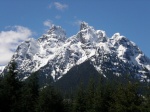
gman- Member
 Re: American Bonsai at the NC Arboretum
Re: American Bonsai at the NC Arboretum
C-dog, Is there life beyond bonsai?... lol. jk
That's a beautiful forest Arthur. Great job keeping it true to the original and developing the canopy to feel like a natural forest.
That's a beautiful forest Arthur. Great job keeping it true to the original and developing the canopy to feel like a natural forest.

Dan W.- Member
 Re: American Bonsai at the NC Arboretum
Re: American Bonsai at the NC Arboretum
Looks so Fresh and revitalized. I love letting things go wild for a season, and having that sense of discovery when you begin to work it again.
Thanks for taking time from your busy schedule to post this forest, it's delightful.
Thanks for taking time from your busy schedule to post this forest, it's delightful.
JudyB- Member
 Re: American Bonsai at the NC Arboretum
Re: American Bonsai at the NC Arboretum
anyone who has ever had the pleasure of meeting arthur joura in person knows what a gracious gentleman he is and despite his initial impression of someone with the handle "beer city snake", this was no exception when i was lucky enough to visit him and the arboretum's collection during a week long visit to beautiful asheville north carolina. (we had initially met earlier this year when he visited milwaukee)
as many of you know, arthur focuses his energy creating bonsai that are both pleasing to the eye and as naturalistic as possible...
in other words, creating a representation of nature that he personally experiences, and not one based on a foreign culture and time…
part of his philosophy is that bonsai, like trees in the wild, should be pleasing from all sides when possible, while also conceding that, yes, one side may be more pleasing and can be considered the “front” for display purposes.
while many traditionalists who insist on certain “rules” may disagree with his approach, I don’t believe that concerns him overly much and i tend to agree with his approach, as he just does what he sees as being “right”.
does that make me a jouraphile ?
probably...
i have certainly been called worse and it sure beats being a jouraphobe !
at any rate, in keeping with his approach I offer some images i made of the arboretum’s collection that I hope present these wonderful specimens in a way not usually seen... be that good or bad. (also i didnt see any need to jot down what species are what as many of these have already been well documented in this thread)
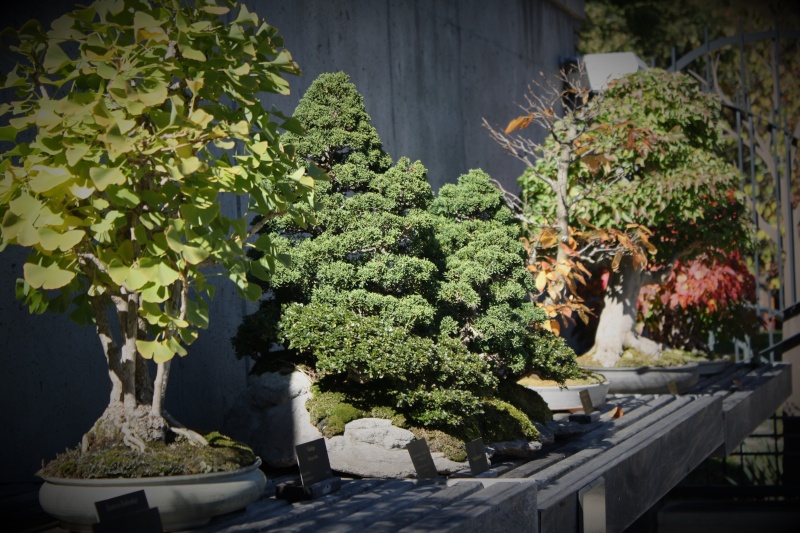
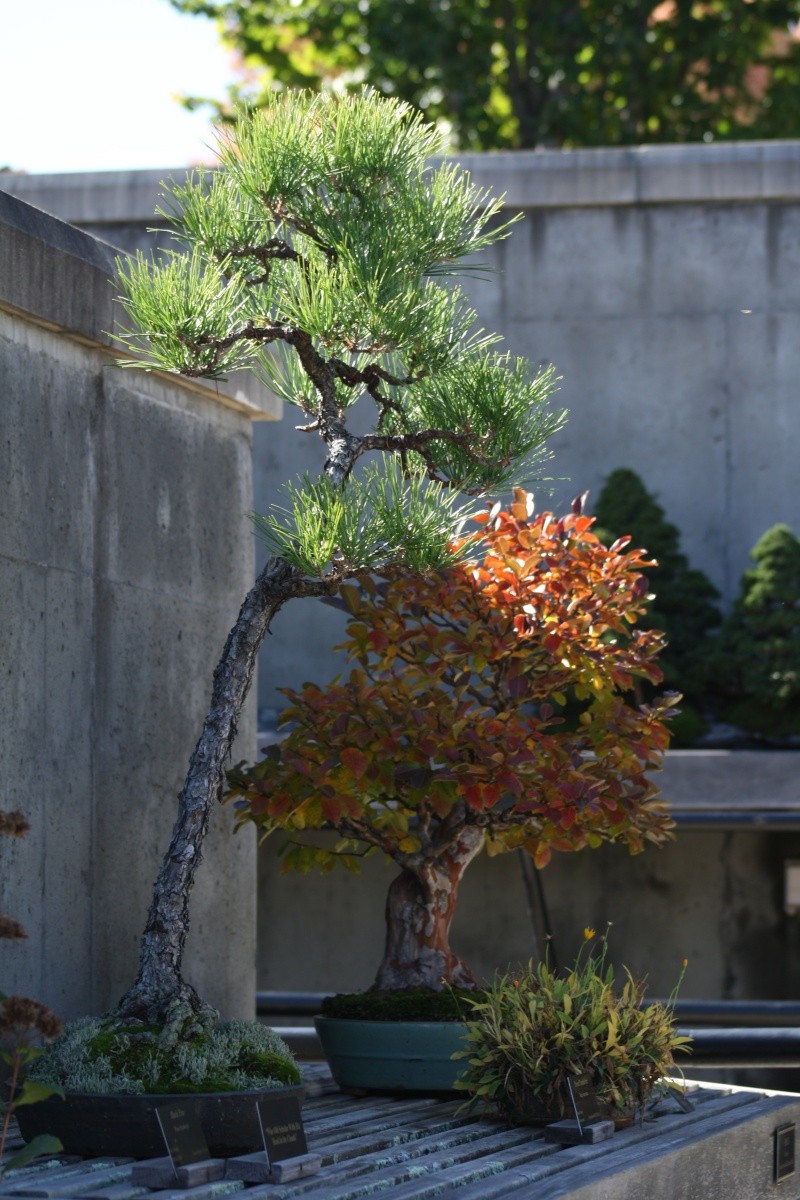
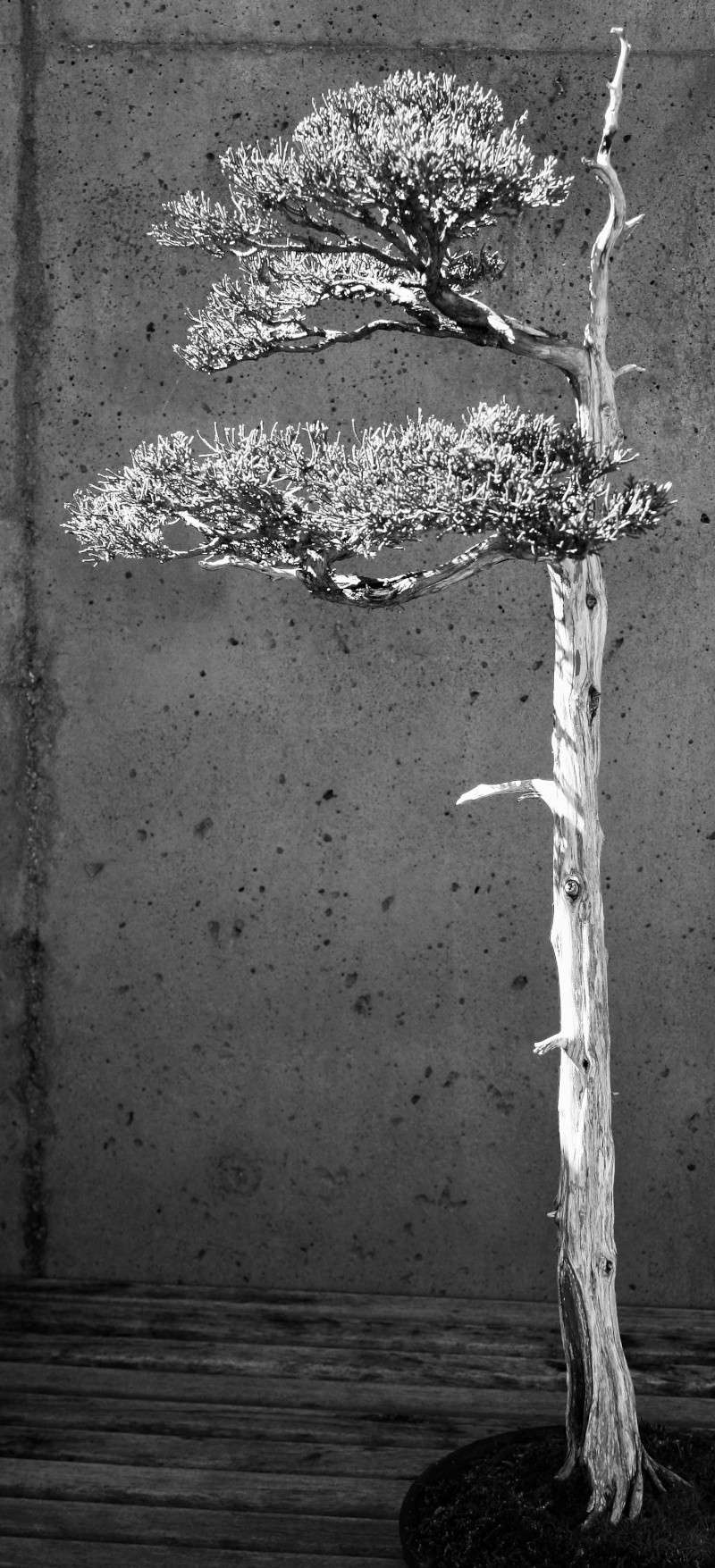
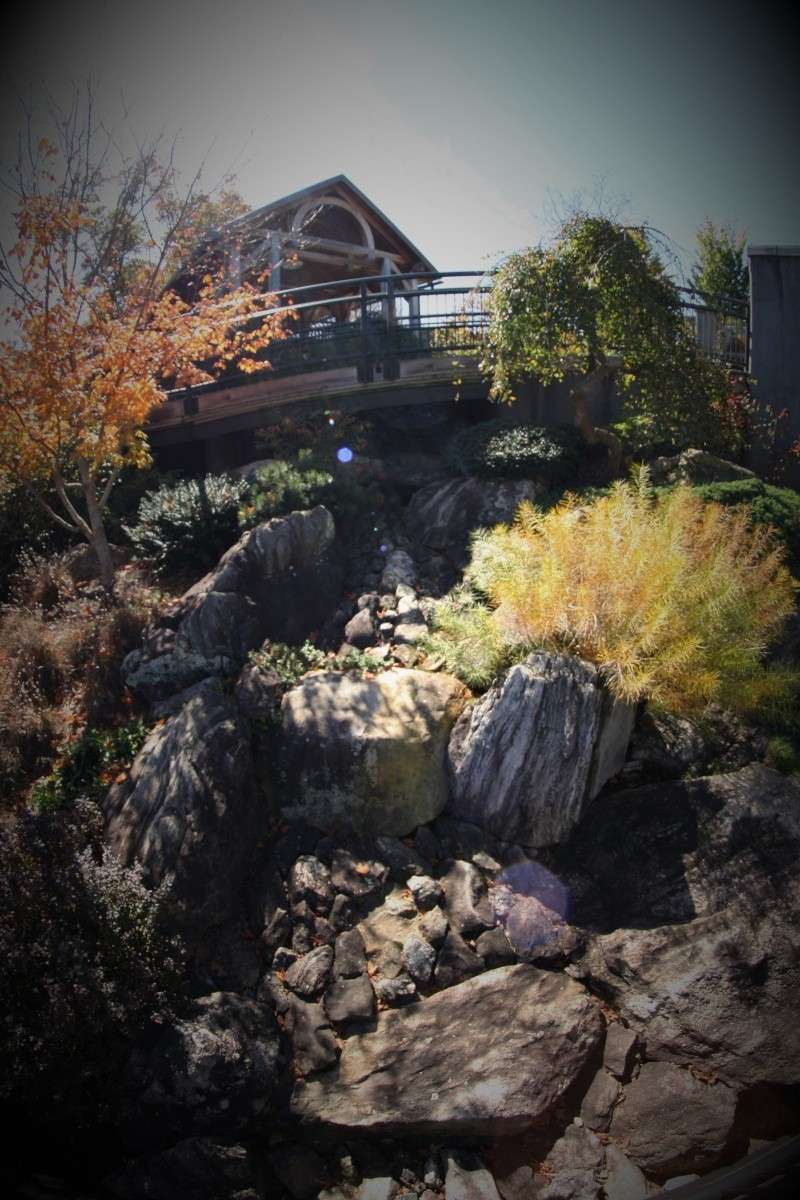


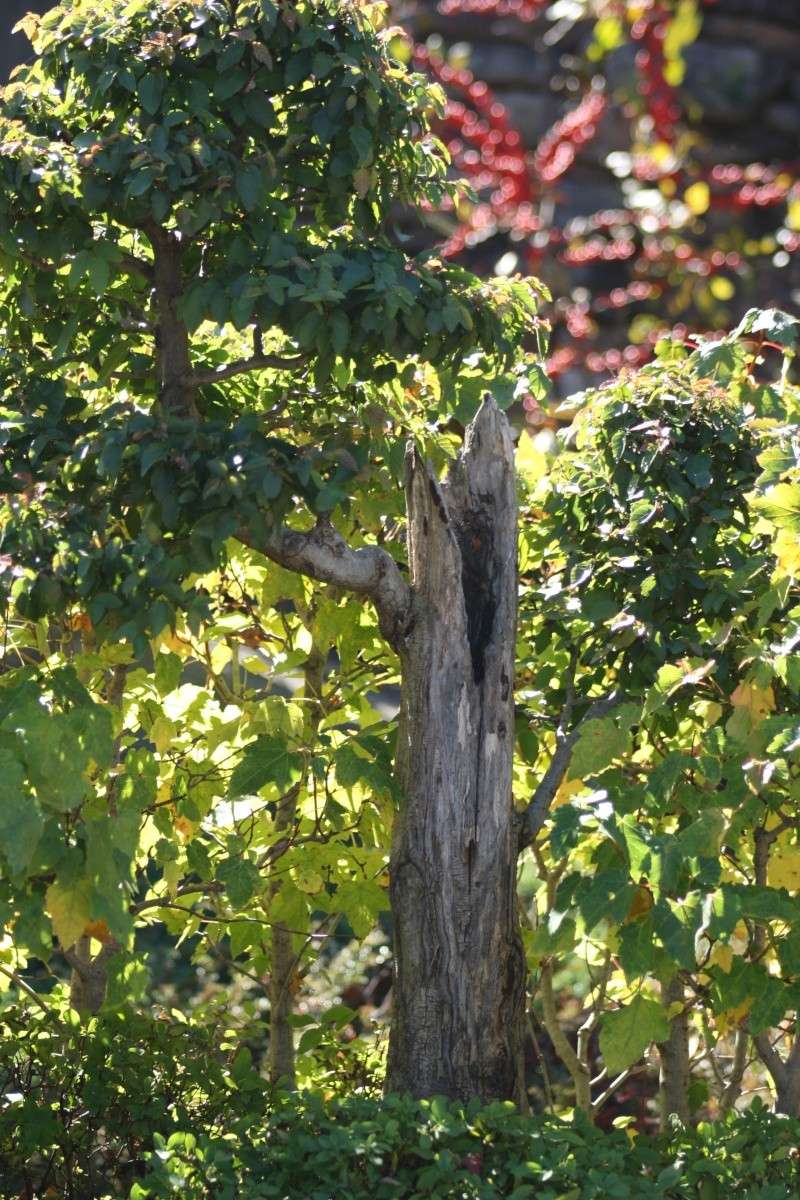
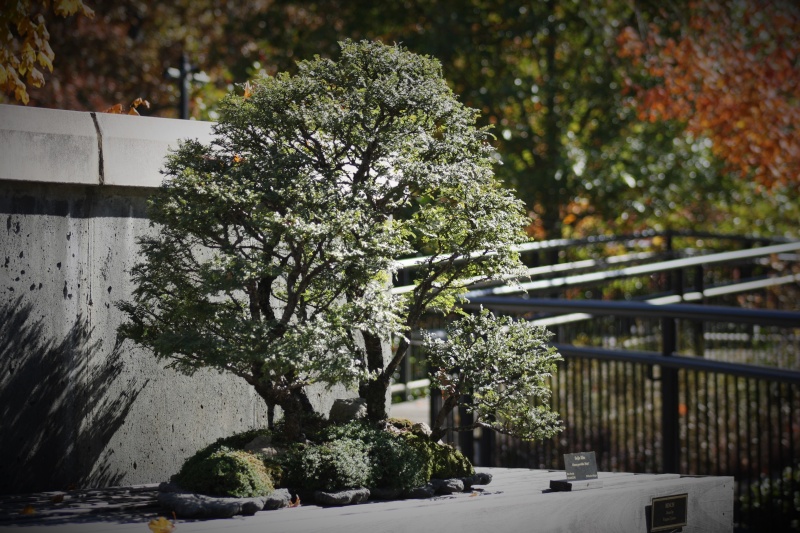
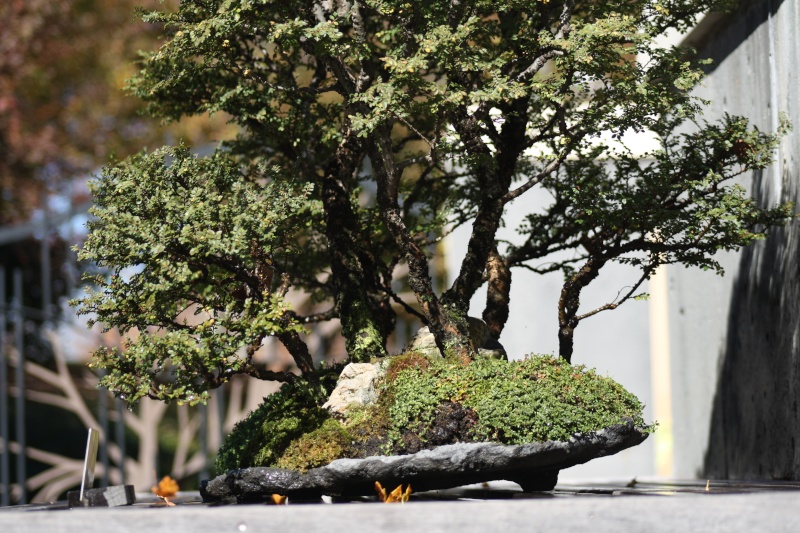
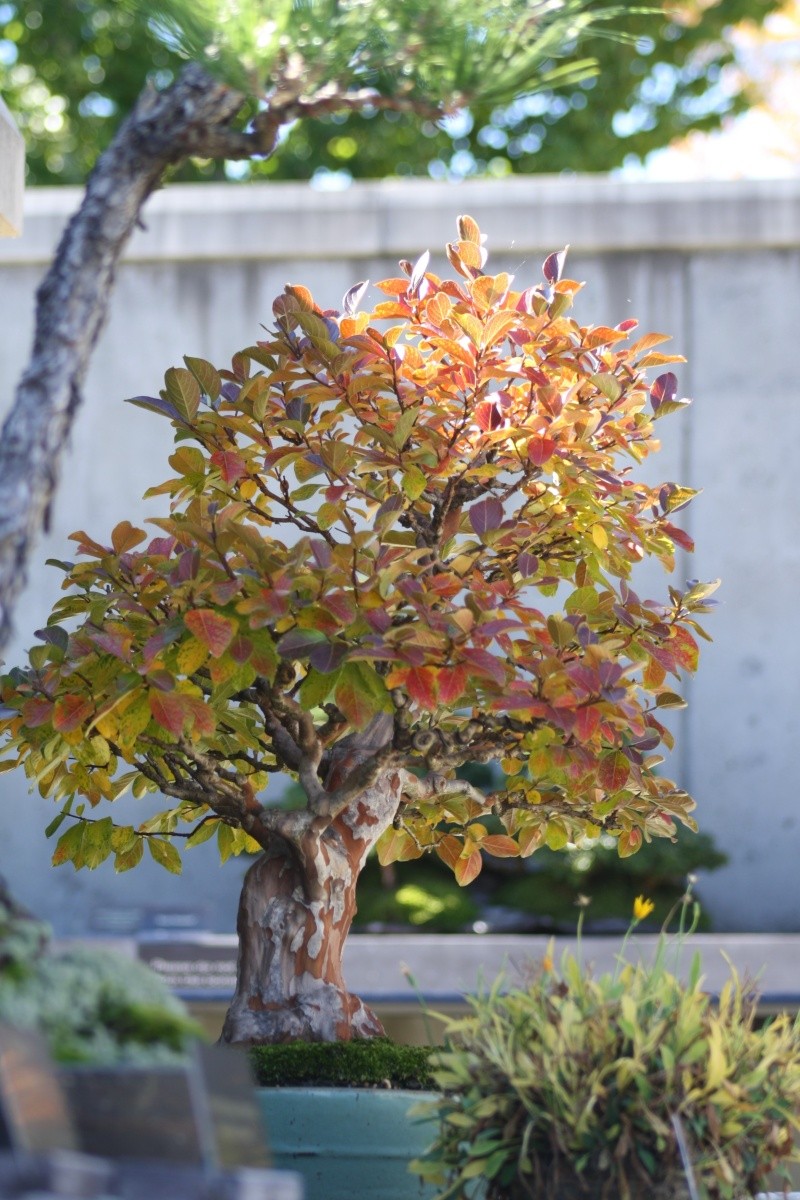

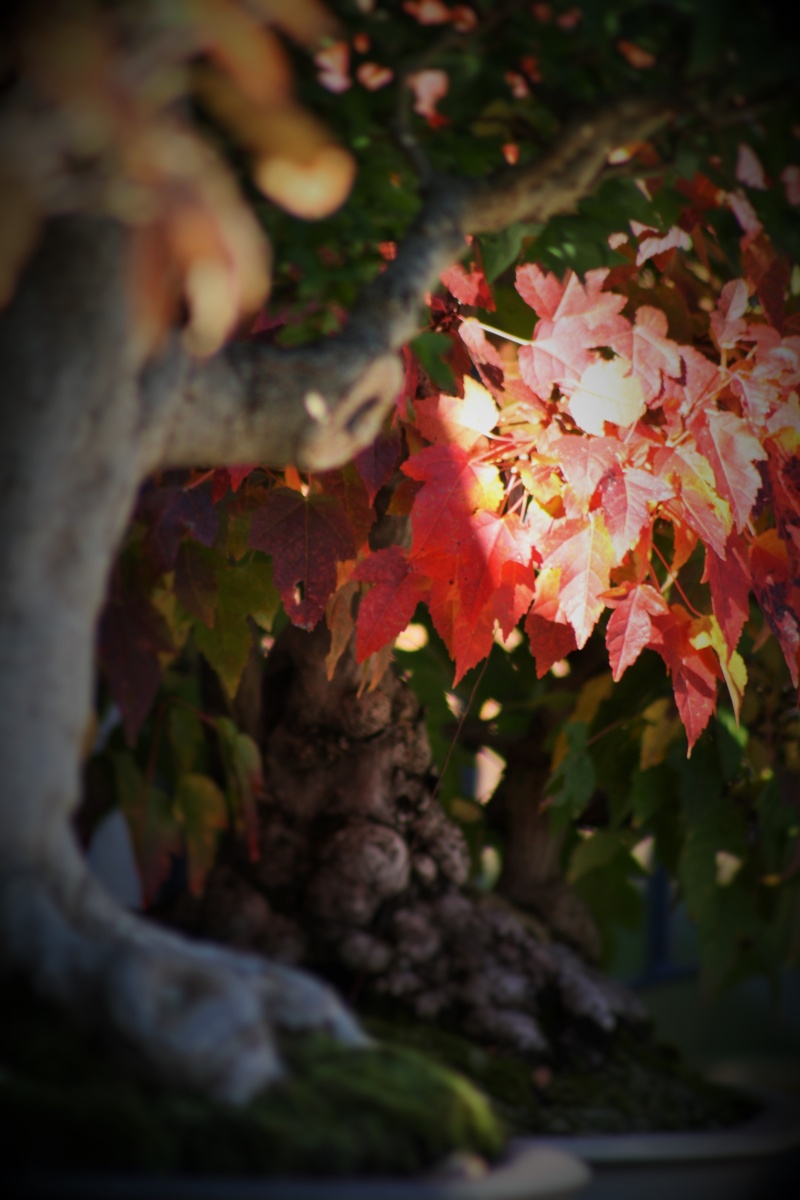

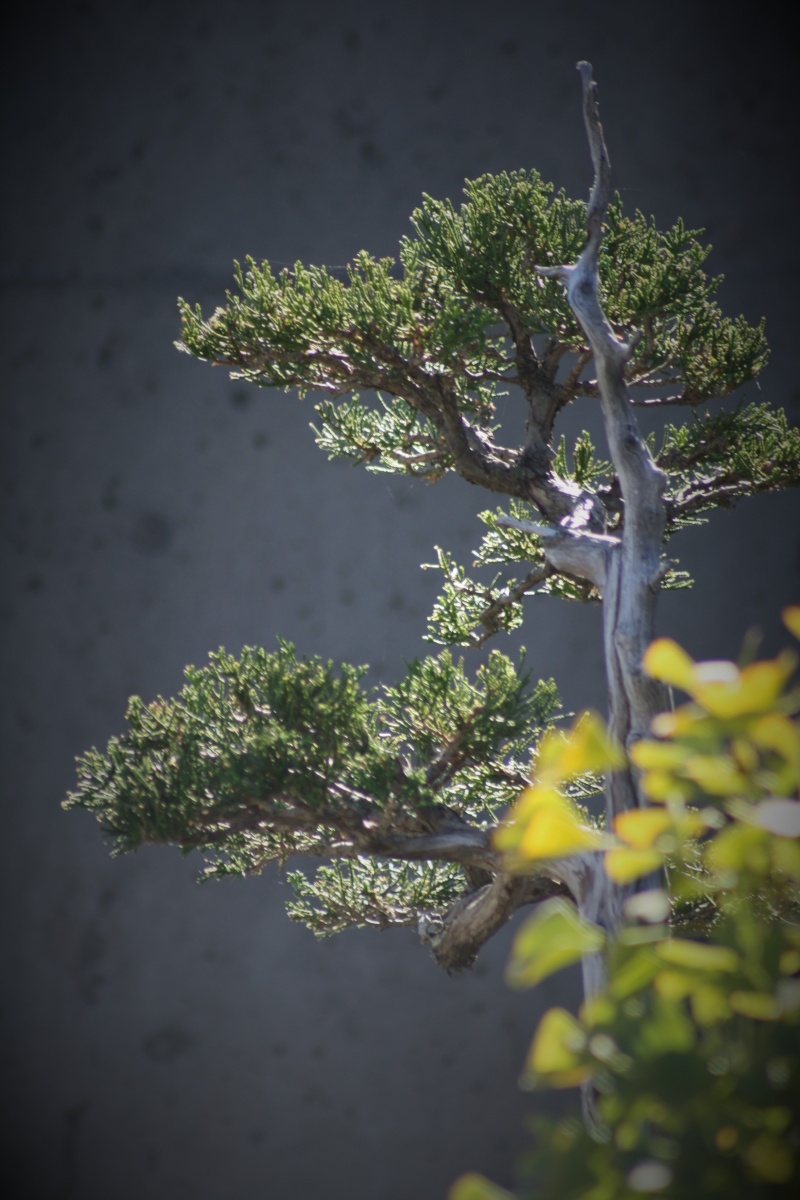

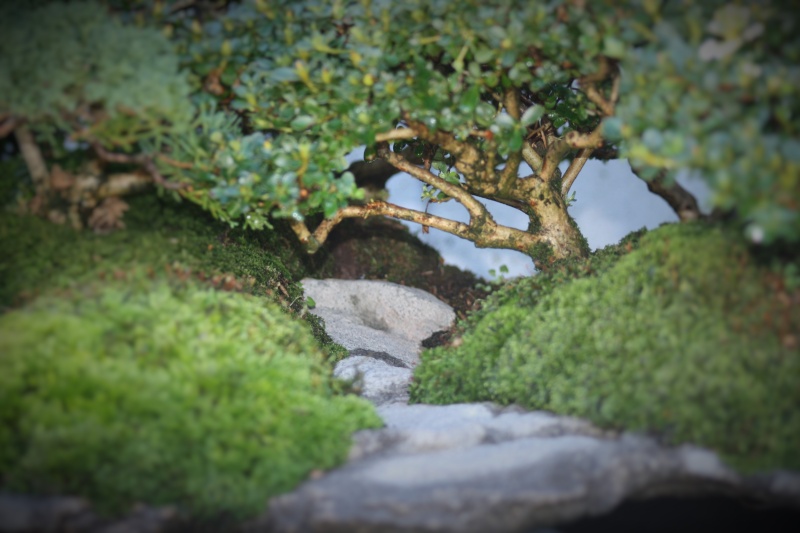
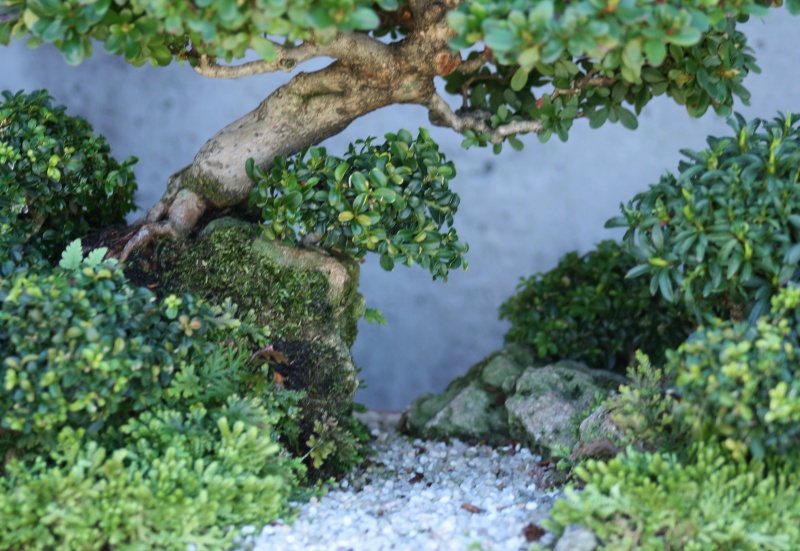
and lastly (for now) arthur said this little planting was the most difficult to photograph,
because of its placement and distracting background (when viewed from the front)...
it actually ended up being my favorite one to shoot...

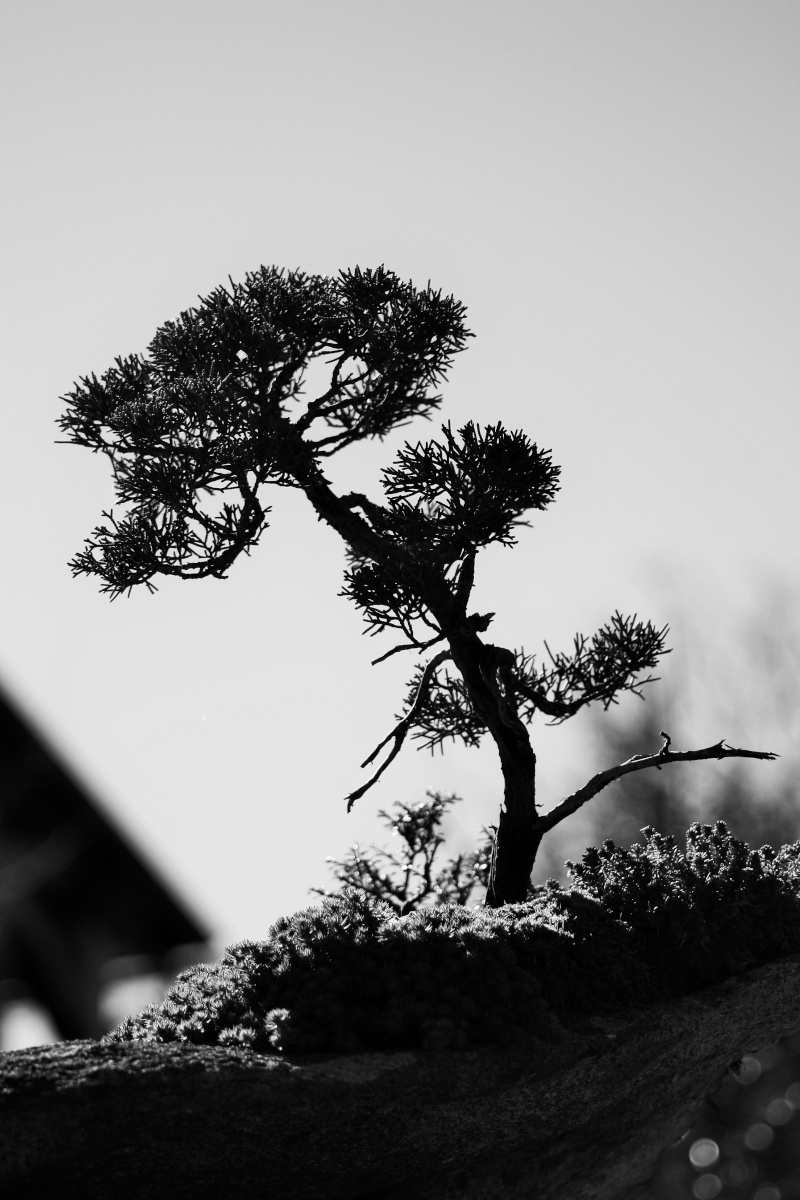
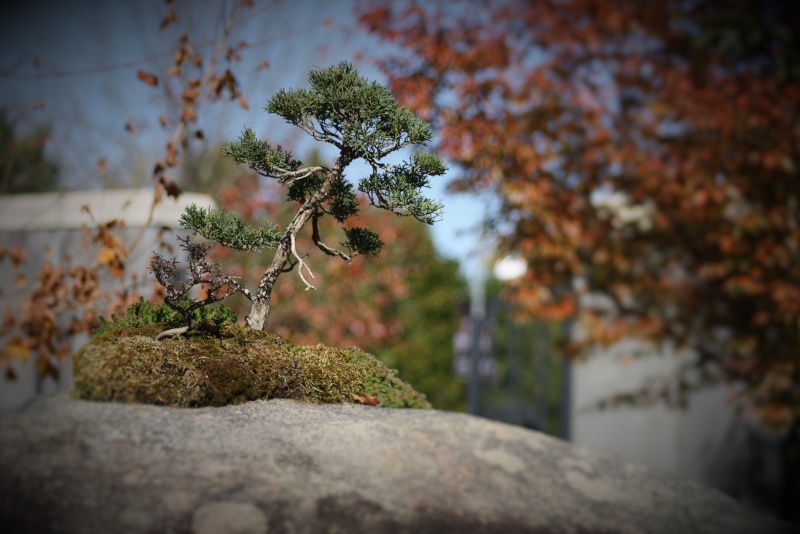
i do have some slightly more traditional views that i will share when i get a bit of time soon...
and for those who don't know, this collection, along with everything behind the scenes is managed and maintained
by arthur, with (i believe) only 1 part time assistant (hey joshua !) and a few volunteers, also part time (hey virginia !),
whom i also had the pleasure of meeting.
as many of you know, arthur focuses his energy creating bonsai that are both pleasing to the eye and as naturalistic as possible...
in other words, creating a representation of nature that he personally experiences, and not one based on a foreign culture and time…
part of his philosophy is that bonsai, like trees in the wild, should be pleasing from all sides when possible, while also conceding that, yes, one side may be more pleasing and can be considered the “front” for display purposes.
while many traditionalists who insist on certain “rules” may disagree with his approach, I don’t believe that concerns him overly much and i tend to agree with his approach, as he just does what he sees as being “right”.
does that make me a jouraphile ?
probably...
i have certainly been called worse and it sure beats being a jouraphobe !
at any rate, in keeping with his approach I offer some images i made of the arboretum’s collection that I hope present these wonderful specimens in a way not usually seen... be that good or bad. (also i didnt see any need to jot down what species are what as many of these have already been well documented in this thread)

















and lastly (for now) arthur said this little planting was the most difficult to photograph,
because of its placement and distracting background (when viewed from the front)...
it actually ended up being my favorite one to shoot...



i do have some slightly more traditional views that i will share when i get a bit of time soon...
and for those who don't know, this collection, along with everything behind the scenes is managed and maintained
by arthur, with (i believe) only 1 part time assistant (hey joshua !) and a few volunteers, also part time (hey virginia !),
whom i also had the pleasure of meeting.

Kevin S - Wisco Bonsai- Member
 Re: American Bonsai at the NC Arboretum
Re: American Bonsai at the NC Arboretum
btw... most of the images were done from a distance w/ a telephoto resulting in some image degradation...

Kevin S - Wisco Bonsai- Member
 Re: American Bonsai at the NC Arboretum
Re: American Bonsai at the NC Arboretum
Thanks for sharing! You took some very nice shots, and it's great to see a different perspective on the trees now and then. 

Dan W.- Member
 Re: American Bonsai at the NC Arboretum
Re: American Bonsai at the NC Arboretum
thanks dan !
its no fun taking the same shot that everyone else has
its no fun taking the same shot that everyone else has

Kevin S - Wisco Bonsai- Member
 Re: American Bonsai at the NC Arboretum
Re: American Bonsai at the NC Arboretum
Lovely, Arthur, Thanks. I don't recall seeing the tree planted on the slanting stone before. It looks like a juniper, but can we see a closer picture?

JimLewis- Member
 Re: American Bonsai at the NC Arboretum
Re: American Bonsai at the NC Arboretum
But, But, But I missed your commentary! However, if I am really honest none is needed, for these beautiful pictures speak for themselves. The only thing better than fall is spring.
Thanks Arthur
Thanks Arthur

DougB- Member
 Re: American Bonsai at the NC Arboretum
Re: American Bonsai at the NC Arboretum
well i am flattered to have my images be even a little bit of an inspiration,
and with the luxury of time and familiarity, you have outdone me arthur !!!
you also created some images that i was aiming for,
such as capturing the seasonal beauty that surrounds the garden in conjunction with the bonsai themselves...
but this one really tickles me... the part of the trunk between the leaves and the base is almost camouflaged against the wall
(i didnt want to take the liberty of cropping your image to exemplify it)

all of them are very well done, my friend.
oh - and jim - from my earlier post, here is something closer of the tree you were asking about.


and with the luxury of time and familiarity, you have outdone me arthur !!!
you also created some images that i was aiming for,
such as capturing the seasonal beauty that surrounds the garden in conjunction with the bonsai themselves...
but this one really tickles me... the part of the trunk between the leaves and the base is almost camouflaged against the wall
(i didnt want to take the liberty of cropping your image to exemplify it)

all of them are very well done, my friend.
oh - and jim - from my earlier post, here is something closer of the tree you were asking about.



Kevin S - Wisco Bonsai- Member
 Re: American Bonsai at the NC Arboretum
Re: American Bonsai at the NC Arboretum
hey jim - i just noticed that the last picture arthur posted was also of the one you were asking about

Kevin S - Wisco Bonsai- Member
 40 Acre Rock Planting
40 Acre Rock Planting
Jim, Dan, Doug, Kevin (the usual suspects) - thanks for participating in the thread.
Kevin - I have a sentimental attachment to that American Hornbeam (Carpinus caroliniana) because it represents one of the very first bonsai I did myself from scratch. Everything from and including the first branch was grown off of a cut-back stump, started in 1993. What really catches my eye every time I look at that bonsai, however, is the eye looking back at me:

Jim - The planting on the large rock is a relatively new piece, which made its public debut in the Bonsai Exhibition Garden at the recently past 19th Carolina Bonsai Expo. In the 6 weeks or so since then it has garnered a great deal of notice and public approval. The problem with it, which is really a problem of the particular space in which it is displayed, and not really that great of a problem at all when you get right down to it, is that it is difficult to get a good photograph of it from the front. In the garden we have 2 free-standing, cut granite display tables, that have no walls directly behind them. When you are there in person and look at a bonsai displayed on one of these tables, your eye, without conscious effort on your part, can easily read the bonsai off the background of other plants in the landscape. But if you make a photograph of the same view, the bonsai disappears into the visual clutter of the background. Yes, this problem may be overcome by use of a shallow depth of field, or by punching in additional light on the subject, or possibly by other means available to more sophisticated photographers, but for those of us in the point-and-shoot crowd the results are disappointing.
In the time it was out in the garden, the best image I was able to get of the planting as seen from the front was this shot where the maple behind the display was in autumn color:

Ironically, it is possible to take a clearly readable photograph of the planting from views other than the front:

It was fitting that this bonsai landscape planting should be shown for the first time at the 19th Carolina Bonsai Expo, because it was created at the 18th Expo, one year earlier. It was put together in a live demonstration by Ken Duncan, John Geanangel and me:

The excellent concave slab of rock, which is what makes this planting what it is, was collected by John. The Shimpaku Juniper (Juniperus chinensis v. sargentii 'Shimpaku') was also supplied by John, so this planting owes much to his talents and generosity. On the other hand, Ken and I did most of the actual work:

While John took the opportunity to pontificate in public, which is something he loves to do:

John did make a passing attempt to help build the planting, but his arm was in a sling at the time so he was physically limited in what he could do. When he tried he looked like a T-Rex doing bonsai:

This planting was inspired by a unique natural area in South Carolina called 40 Acre Rock Heritage Preserve. Ken and John had been there many times, and took me to see the place:
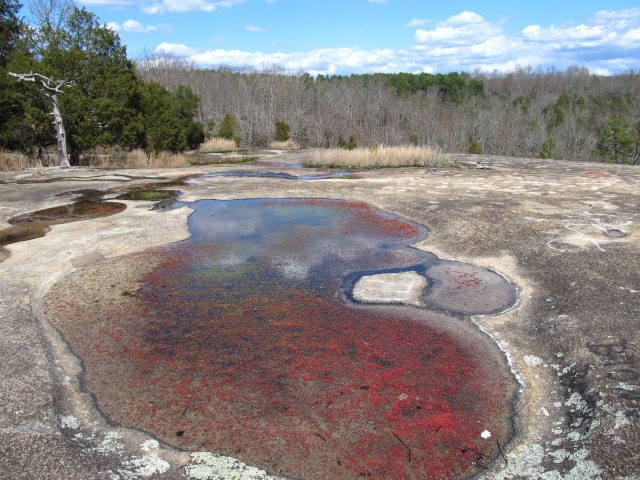
We decided during that hike that we should do a bonsai planting to represent the 40 Acre Rock experience. That idea sat on the back burner for awhile, along with sundry other great ideas, until John turned up with the slab. We then discussed how best to use the thing, and decided that a minimalist planting on one small outer portion of the rock would create an interesting and unusual composition. That design scheme would also be true to the experience of being at 40 Acre Rock, where what impresses the viewer most is the vast expanse of exposed, weathered stone:

We went for our hike in February and there was a lot of water in pools and streams running along the rock face. We toyed for awhile with ways we might incorporate water in the planting, but decided against it. If a person goes to 40 Acre Rock in the heat of the SC summer, they are not likely to see much water up there anyway, but the big rock still impresses.
Here and there on the rock face are depressions and cracks which allow for plant life to take hold. Some of these plants are trees - Eastern Redcedars (Juniperus virginiana), mostly - and they are all stunted and gnarly due to the harsh growing conditions:
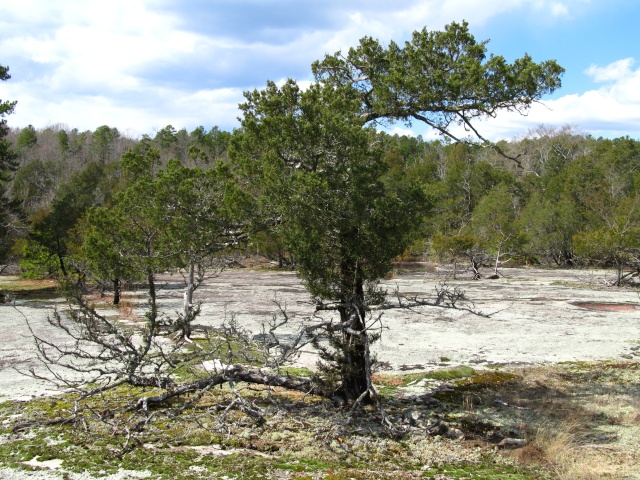
Earlier I called the 40 Acre Rock site "unique", and it is, although the large, exposed, dome rock landscape can be found scattered about in other areas of the Southern Appalachian Mountains. 2 other such locations with which I am familiar are both in North Carolina. One is Looking Glass Rock, in the Pisgah National Forest:
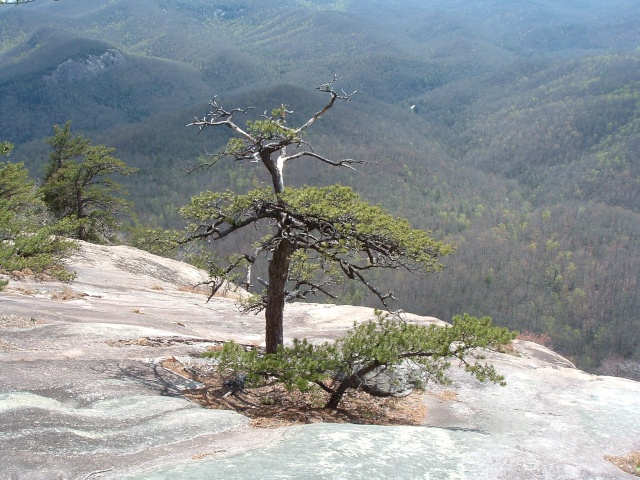
And the other is Stone Mountain State Park:
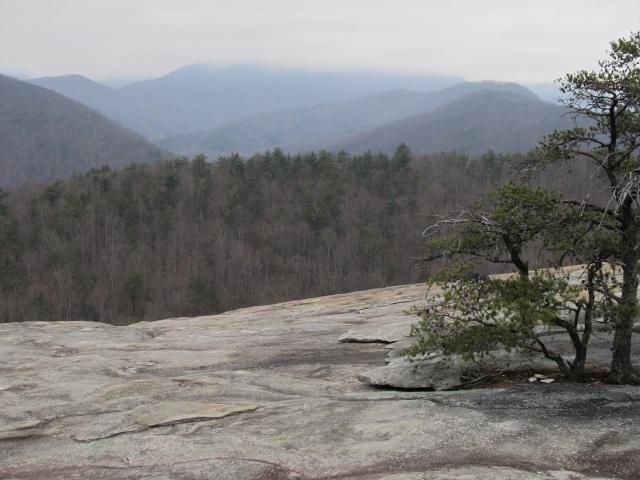
All in all, I think this planting is a fine example of an American bonsai, in the Naturalistic style. Strangely, some people still insist that neither of those things actually exist!
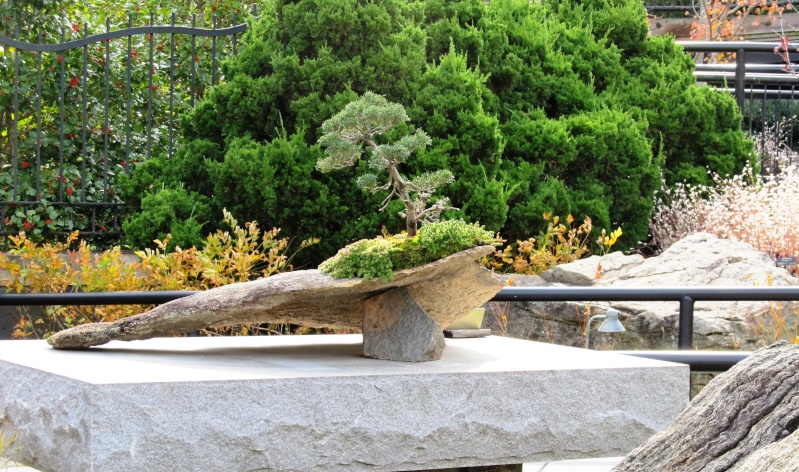
Kevin - I have a sentimental attachment to that American Hornbeam (Carpinus caroliniana) because it represents one of the very first bonsai I did myself from scratch. Everything from and including the first branch was grown off of a cut-back stump, started in 1993. What really catches my eye every time I look at that bonsai, however, is the eye looking back at me:

Jim - The planting on the large rock is a relatively new piece, which made its public debut in the Bonsai Exhibition Garden at the recently past 19th Carolina Bonsai Expo. In the 6 weeks or so since then it has garnered a great deal of notice and public approval. The problem with it, which is really a problem of the particular space in which it is displayed, and not really that great of a problem at all when you get right down to it, is that it is difficult to get a good photograph of it from the front. In the garden we have 2 free-standing, cut granite display tables, that have no walls directly behind them. When you are there in person and look at a bonsai displayed on one of these tables, your eye, without conscious effort on your part, can easily read the bonsai off the background of other plants in the landscape. But if you make a photograph of the same view, the bonsai disappears into the visual clutter of the background. Yes, this problem may be overcome by use of a shallow depth of field, or by punching in additional light on the subject, or possibly by other means available to more sophisticated photographers, but for those of us in the point-and-shoot crowd the results are disappointing.
In the time it was out in the garden, the best image I was able to get of the planting as seen from the front was this shot where the maple behind the display was in autumn color:

Ironically, it is possible to take a clearly readable photograph of the planting from views other than the front:

It was fitting that this bonsai landscape planting should be shown for the first time at the 19th Carolina Bonsai Expo, because it was created at the 18th Expo, one year earlier. It was put together in a live demonstration by Ken Duncan, John Geanangel and me:

The excellent concave slab of rock, which is what makes this planting what it is, was collected by John. The Shimpaku Juniper (Juniperus chinensis v. sargentii 'Shimpaku') was also supplied by John, so this planting owes much to his talents and generosity. On the other hand, Ken and I did most of the actual work:

While John took the opportunity to pontificate in public, which is something he loves to do:

John did make a passing attempt to help build the planting, but his arm was in a sling at the time so he was physically limited in what he could do. When he tried he looked like a T-Rex doing bonsai:

This planting was inspired by a unique natural area in South Carolina called 40 Acre Rock Heritage Preserve. Ken and John had been there many times, and took me to see the place:

We decided during that hike that we should do a bonsai planting to represent the 40 Acre Rock experience. That idea sat on the back burner for awhile, along with sundry other great ideas, until John turned up with the slab. We then discussed how best to use the thing, and decided that a minimalist planting on one small outer portion of the rock would create an interesting and unusual composition. That design scheme would also be true to the experience of being at 40 Acre Rock, where what impresses the viewer most is the vast expanse of exposed, weathered stone:

We went for our hike in February and there was a lot of water in pools and streams running along the rock face. We toyed for awhile with ways we might incorporate water in the planting, but decided against it. If a person goes to 40 Acre Rock in the heat of the SC summer, they are not likely to see much water up there anyway, but the big rock still impresses.
Here and there on the rock face are depressions and cracks which allow for plant life to take hold. Some of these plants are trees - Eastern Redcedars (Juniperus virginiana), mostly - and they are all stunted and gnarly due to the harsh growing conditions:

Earlier I called the 40 Acre Rock site "unique", and it is, although the large, exposed, dome rock landscape can be found scattered about in other areas of the Southern Appalachian Mountains. 2 other such locations with which I am familiar are both in North Carolina. One is Looking Glass Rock, in the Pisgah National Forest:

And the other is Stone Mountain State Park:

All in all, I think this planting is a fine example of an American bonsai, in the Naturalistic style. Strangely, some people still insist that neither of those things actually exist!


Arthur Joura- Member
 Re: American Bonsai at the NC Arboretum
Re: American Bonsai at the NC Arboretum
I like it. This reminds me of many areas out here in the Rockies.

Dan W.- Member
 Re: American Bonsai at the NC Arboretum
Re: American Bonsai at the NC Arboretum
Nice post Arthur! BUT T-Rex....really...bully:) Although I must admit that I kind of enjoyed letting the minions do the work:)
Have you tried to display it balanced on a center post? Might be better the way you have it...
Hopefully the complimentary piece will get put together this Spring
John
Have you tried to display it balanced on a center post? Might be better the way you have it...
Hopefully the complimentary piece will get put together this Spring
John
jgeanangel- Member
 Re: American Bonsai at the NC Arboretum
Re: American Bonsai at the NC Arboretum
hey john !
i thought the t-rex jibe was HIGH-LARRY-US !!!
brought to mind many "far side" comic panals...
btw - i dig your youtube vids - keep 'em coming.
and arthur - thats pretty rad re: the hornbeam.
if/when i make it back down i will give it a more better eye-balling w/ that in mind
(and speaking of eyeballs, that eye did jump out at me too even w/o your cropping)
did jump out at me too even w/o your cropping)
i thought the t-rex jibe was HIGH-LARRY-US !!!
brought to mind many "far side" comic panals...
btw - i dig your youtube vids - keep 'em coming.
and arthur - thats pretty rad re: the hornbeam.
if/when i make it back down i will give it a more better eye-balling w/ that in mind
(and speaking of eyeballs, that eye

Kevin S - Wisco Bonsai- Member
 Doubling Down on Design
Doubling Down on Design
Jim, Dan, John, Kevin - thank you for your replies!
Back on the second weekend of this past October, during a stretch when I was unable to post anything to this thread, the NC Arboretum hosted the 19th annual Carolina Bonsai Expo. (My friend John G. made a video of it, and anyone who is interested and has not yet seen the video can do so here: https://www.youtube.com/watch?v=zqMtzxPVBTY) Last year I wrote extensively on this thread about the 18th Expo (here is a link to that:https://ibonsaiclub.forumotion.com/t12772p105-bonsai-at-the-nc-arboretum#148362 ), and this year's event was very similar. Of course, the displays were different, and the educational programs were different, and the guest artist was different, but the overall format of the weekend was very much the same. So I will not attempt at this late date to write a "catch-up" post about the 19th Expo, but I do want to call attention to one small facet of it.
Every year I produce a graphic image that serves as the Expo logo, and this image always features a bonsai from the Arboretum's collection. Here is the logo we used this year:
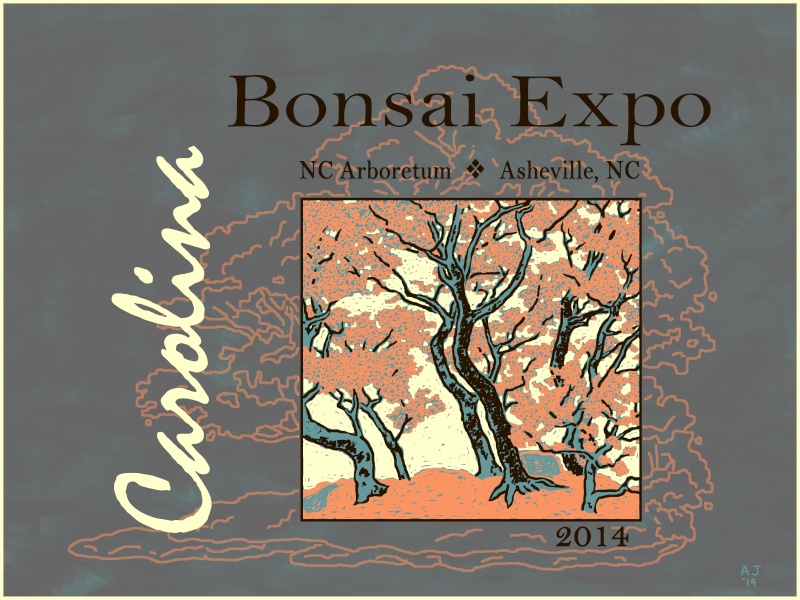
The bonsai featured in this image is a Seiju Elm (Ulmus parvifolia 'Seiju') landscape planting. Here is a photo of the planting from this summer:

I really enjoy this elm landscape! Every time I look at it, my eye is unfailingly drawn to the dynamic relationship between the trunk of the primary tree and the trunk of one of the secondary trees, which is located behind and slightly to the left of the primary. The 2 trees have a strikingly similar movement in their trunks, so that seen together they seem to echo one another:

In doing the graphic image I wanted to highlight that particular aspect of the planting. The whole piece looks so convincing to me as a representation of deciduous trees growing wild in nature, and yet it is so cleverly and artistically designed. I wanted to isolate that detail of the scene and present it somehow on its own, while simultaneously representing the fact that it is part of a larger entity. My hope was to have the viewer first identify the image as being of trees and then, only after some closer observation, recognize it as a bonsai.
The Seiju Elm landscape in question was done by the great Chinese penjing artist, Qingquan 'Brook' Zhao. Mr. Zhao was the guest artist at the 2004 Carolina Bonsai Expo, and the elm landscape was his demonstration piece. Here is photo of Mr. Zhao posed next to the work shortly after its completion:

Most of the elm trees used were started by me as cuttings sometime in the mid-1990's. On an earlier visit to the Arboretum, Mr. Zhao took note of them in the nursery and said that he would very much like to work with them, to use them to make a landscape planting. I was naturally pleased to be able to facilitate his desire when he returned in '04. The slab the planting sits upon is made of Portland cement, and was created by my friend Ken Duncan. Mr. Zhao thought so well of Ken's work that he asked him to make a slab for another demonstration piece Mr. Zhao would do the following year at the 5th World Bonsai Convention in Washington, DC.
In the 10 years that I have been maintaining and further developing this bonsai, it has provided me with a rich education in Naturalistic design. Mr. Zhao works in what is called the Yangzhou School of penjing. To my eye, much of the work done in this school seems to be strongly influenced by the natural example, and as such might correctly be identified as Naturalistic in its overall conception. Yet I cannot claim to be a student of the Yangzhou School. I have never studied penjing of any sort in a formal way, so these are my opinions I offer here and nothing more. Still, I do assiduously study the forms of wild trees as I experience them, and in looking at the way Mr. Zhao used the elms we gave him I can see that he too has spent time studying wild trees.
As regards the echoing tree trunks I mentioned earlier, I think of them as testimony to Mr. Zhao's creative artistry. The elm trees he had to choose from for his demonstration were nice material, but they were all the same age. The cuttings had been struck at the same time, from similar sized pieces of the same parent plant, so there was not so much size difference between them. In fact, we had to purchase 3 younger Seiju Elms from a vendor at the Expo, just so there would be at least some variety to the sizes of the trees in the planting. What we ultimately did not have was any single tree that was noticeably larger than the rest, the kind you would want to have when making a group planting, to use as a primary tree or focal point. Mr. Zhao never complained about this or even mentioned it in any way. Instead, he found the 2 trees with the similar movement and planted them in such a way that they, together, form the focal point. He did not mention anything about doing this, either. He just did it. The effectiveness of this creative solution still impresses me after a decade of exposure to it.
To conclude, I offer you 2 more images of this Seiju Elm landscape. The first is the first "portrait" shot I have of it, taken in 2005, 1 year after its creation, and the second is from 1 year ago, when an early dusting of snow came through before our bonsai were put up for the winter. In these you can not only see the effectiveness of this piece in different seasons, you can also track the changes that have taken place over time:

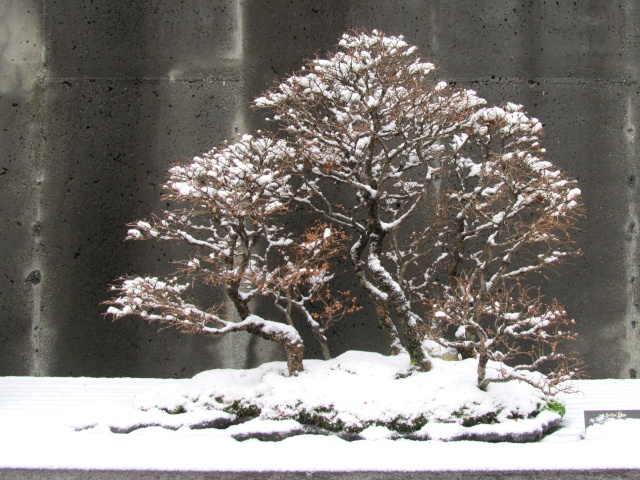
Back on the second weekend of this past October, during a stretch when I was unable to post anything to this thread, the NC Arboretum hosted the 19th annual Carolina Bonsai Expo. (My friend John G. made a video of it, and anyone who is interested and has not yet seen the video can do so here: https://www.youtube.com/watch?v=zqMtzxPVBTY) Last year I wrote extensively on this thread about the 18th Expo (here is a link to that:https://ibonsaiclub.forumotion.com/t12772p105-bonsai-at-the-nc-arboretum#148362 ), and this year's event was very similar. Of course, the displays were different, and the educational programs were different, and the guest artist was different, but the overall format of the weekend was very much the same. So I will not attempt at this late date to write a "catch-up" post about the 19th Expo, but I do want to call attention to one small facet of it.
Every year I produce a graphic image that serves as the Expo logo, and this image always features a bonsai from the Arboretum's collection. Here is the logo we used this year:

The bonsai featured in this image is a Seiju Elm (Ulmus parvifolia 'Seiju') landscape planting. Here is a photo of the planting from this summer:

I really enjoy this elm landscape! Every time I look at it, my eye is unfailingly drawn to the dynamic relationship between the trunk of the primary tree and the trunk of one of the secondary trees, which is located behind and slightly to the left of the primary. The 2 trees have a strikingly similar movement in their trunks, so that seen together they seem to echo one another:

In doing the graphic image I wanted to highlight that particular aspect of the planting. The whole piece looks so convincing to me as a representation of deciduous trees growing wild in nature, and yet it is so cleverly and artistically designed. I wanted to isolate that detail of the scene and present it somehow on its own, while simultaneously representing the fact that it is part of a larger entity. My hope was to have the viewer first identify the image as being of trees and then, only after some closer observation, recognize it as a bonsai.
The Seiju Elm landscape in question was done by the great Chinese penjing artist, Qingquan 'Brook' Zhao. Mr. Zhao was the guest artist at the 2004 Carolina Bonsai Expo, and the elm landscape was his demonstration piece. Here is photo of Mr. Zhao posed next to the work shortly after its completion:

Most of the elm trees used were started by me as cuttings sometime in the mid-1990's. On an earlier visit to the Arboretum, Mr. Zhao took note of them in the nursery and said that he would very much like to work with them, to use them to make a landscape planting. I was naturally pleased to be able to facilitate his desire when he returned in '04. The slab the planting sits upon is made of Portland cement, and was created by my friend Ken Duncan. Mr. Zhao thought so well of Ken's work that he asked him to make a slab for another demonstration piece Mr. Zhao would do the following year at the 5th World Bonsai Convention in Washington, DC.
In the 10 years that I have been maintaining and further developing this bonsai, it has provided me with a rich education in Naturalistic design. Mr. Zhao works in what is called the Yangzhou School of penjing. To my eye, much of the work done in this school seems to be strongly influenced by the natural example, and as such might correctly be identified as Naturalistic in its overall conception. Yet I cannot claim to be a student of the Yangzhou School. I have never studied penjing of any sort in a formal way, so these are my opinions I offer here and nothing more. Still, I do assiduously study the forms of wild trees as I experience them, and in looking at the way Mr. Zhao used the elms we gave him I can see that he too has spent time studying wild trees.
As regards the echoing tree trunks I mentioned earlier, I think of them as testimony to Mr. Zhao's creative artistry. The elm trees he had to choose from for his demonstration were nice material, but they were all the same age. The cuttings had been struck at the same time, from similar sized pieces of the same parent plant, so there was not so much size difference between them. In fact, we had to purchase 3 younger Seiju Elms from a vendor at the Expo, just so there would be at least some variety to the sizes of the trees in the planting. What we ultimately did not have was any single tree that was noticeably larger than the rest, the kind you would want to have when making a group planting, to use as a primary tree or focal point. Mr. Zhao never complained about this or even mentioned it in any way. Instead, he found the 2 trees with the similar movement and planted them in such a way that they, together, form the focal point. He did not mention anything about doing this, either. He just did it. The effectiveness of this creative solution still impresses me after a decade of exposure to it.
To conclude, I offer you 2 more images of this Seiju Elm landscape. The first is the first "portrait" shot I have of it, taken in 2005, 1 year after its creation, and the second is from 1 year ago, when an early dusting of snow came through before our bonsai were put up for the winter. In these you can not only see the effectiveness of this piece in different seasons, you can also track the changes that have taken place over time:



Arthur Joura- Member
Page 12 of 40 •  1 ... 7 ... 11, 12, 13 ... 26 ... 40
1 ... 7 ... 11, 12, 13 ... 26 ... 40 
 Similar topics
Similar topics» American Bonsai at the NC Arboretum
» WISTERIA BONSAI AT INTERNATIONAL BONSAI ARBORETUM
» Ashville arboretum bonsai
» Show the Autumncolour from your bonsai
» Trip to the Rochester Arboretum
» WISTERIA BONSAI AT INTERNATIONAL BONSAI ARBORETUM
» Ashville arboretum bonsai
» Show the Autumncolour from your bonsai
» Trip to the Rochester Arboretum
Page 12 of 40
Permissions in this forum:
You cannot reply to topics in this forum















